ERC Project LubSat
 LubSat is a European Research Council (Starting Grant) funded research project for 5 years (2017-22) with a value of €1.5 million to understand the role of oral lubricity on satiety. In particular, our quantitative multi-scale understanding of lubrication of the human salivary film when exposed to stimuli from food biomolecules, which in turn can have significant appetite suppression consequences, remains poorly understood. The key limitation to accurately measure oral lubrication is the lack of availability of tribo-contact surfaces that effectively emulate the oral surfaces (i.e. the soft, slippery mucous-coated human tongue and the upper palate). The project will apply classical theories from Physics and tools from Mechanical Engineering to design novel soft lubricious surfaces emulating our saliva-coated human tongue. This will be then used to create fundamental understanding of how food molecules lubricate the oral surfaces and the implications this has on the satisfaction of the food and perceived satiety.
LubSat is a European Research Council (Starting Grant) funded research project for 5 years (2017-22) with a value of €1.5 million to understand the role of oral lubricity on satiety. In particular, our quantitative multi-scale understanding of lubrication of the human salivary film when exposed to stimuli from food biomolecules, which in turn can have significant appetite suppression consequences, remains poorly understood. The key limitation to accurately measure oral lubrication is the lack of availability of tribo-contact surfaces that effectively emulate the oral surfaces (i.e. the soft, slippery mucous-coated human tongue and the upper palate). The project will apply classical theories from Physics and tools from Mechanical Engineering to design novel soft lubricious surfaces emulating our saliva-coated human tongue. This will be then used to create fundamental understanding of how food molecules lubricate the oral surfaces and the implications this has on the satisfaction of the food and perceived satiety.
Follow us on this page to receive updates on project outcomes!!
New paper titled "Oral Astringency in plant proteins: An underestimated issue in formulating next-generation plant-based foods" published in Annual Reviews of Food Science and Technology
Ensuring the supply of affordable, palatable, healthy, and sustainable nutrients to feed the growing population without transgressing the planetary boundaries remains a key challenge in the food science community. A dietary transition toward low-emission, plant-based foods, with less reliance on animal agriculture, is advocated for sustainability, health, and ethical reasons. A major hurdle for mainstream adoption of plant-based foods is their poor sensorial performance, such as non-juicy and astringent textures as well as various off-flavors. This review published in Annual Reviews of Food Science & Technology https://doi.org/10.1146/annurev-food-072023-034510 presents the current understanding of astringency and oral friction of plant-based foods. It focuses on plant proteins and
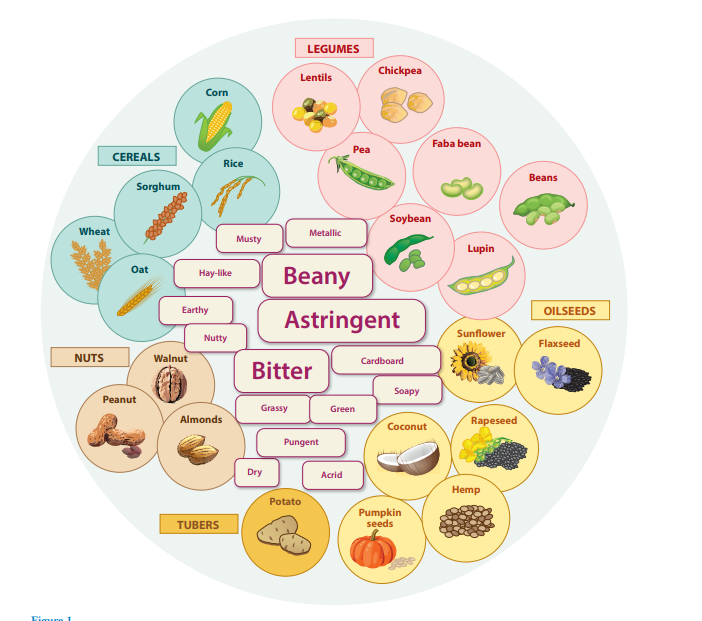 their application in plant-based meat and dairy analogs. In addition, the latest advances in the quantitative characterization of astringency using tribology, electrochemistry, and cellular tools are covered. Although the presence of polyphenols is often hypothesized to be the core reason behind astringency, systematic investigation of plant proteins with/without intrinsic polyphenols in the presence or absence of salivary proteins using temporal sensory studies supported by tribological evaluation is missing. The review also proposes easy-to-implement colloidal strategies such as microgelation using heat and shear, glycation using in situ processing with carbohydrates and coacervation using fine tuning of pH and ions that may mitigate astringency issues. For instance, there is further need for research to tailor colloidal strategies for reducing astringency by altering carbohydrate type and ratio, solution conditions (pH and ionic strength), and thermal processing conditions (time and temperature) during food processing of plant proteins to create glycated plant proteins with appropriate properties. Multidisciplinary studies involving protein and saliva chemistry, colloid science, cell biology, and sensory analysis can open up new possibilities for creating sustainable yet pleasurable foods, thereby facilitating the transition to a more ethical, environmentally friendly, and healthy diet.
their application in plant-based meat and dairy analogs. In addition, the latest advances in the quantitative characterization of astringency using tribology, electrochemistry, and cellular tools are covered. Although the presence of polyphenols is often hypothesized to be the core reason behind astringency, systematic investigation of plant proteins with/without intrinsic polyphenols in the presence or absence of salivary proteins using temporal sensory studies supported by tribological evaluation is missing. The review also proposes easy-to-implement colloidal strategies such as microgelation using heat and shear, glycation using in situ processing with carbohydrates and coacervation using fine tuning of pH and ions that may mitigate astringency issues. For instance, there is further need for research to tailor colloidal strategies for reducing astringency by altering carbohydrate type and ratio, solution conditions (pH and ionic strength), and thermal processing conditions (time and temperature) during food processing of plant proteins to create glycated plant proteins with appropriate properties. Multidisciplinary studies involving protein and saliva chemistry, colloid science, cell biology, and sensory analysis can open up new possibilities for creating sustainable yet pleasurable foods, thereby facilitating the transition to a more ethical, environmentally friendly, and healthy diet.
New paper titled "Glycation influencing lubrication: Tribology principles derived from nature to inspire future food colloid design" published in Current Opinion in Colloid and Interface Science
The exploration of glycation within the ambit of colloidal sciences unveils a nuanced understanding of the intricate interplay between nature and food. Glycation, a non-enzymatic process involving the reaction between reducing sugars and proteins, is gaining importance in both biological and food systems. In this review, published in Current Opinion in Colloids and Interface Science (https://doi.org/10.1016/j.cocis.2023.101782), the multifaceted roles of glycation is discussed emphasizing its physiological consequences and its pivotal role in food colloids (Figure 1).
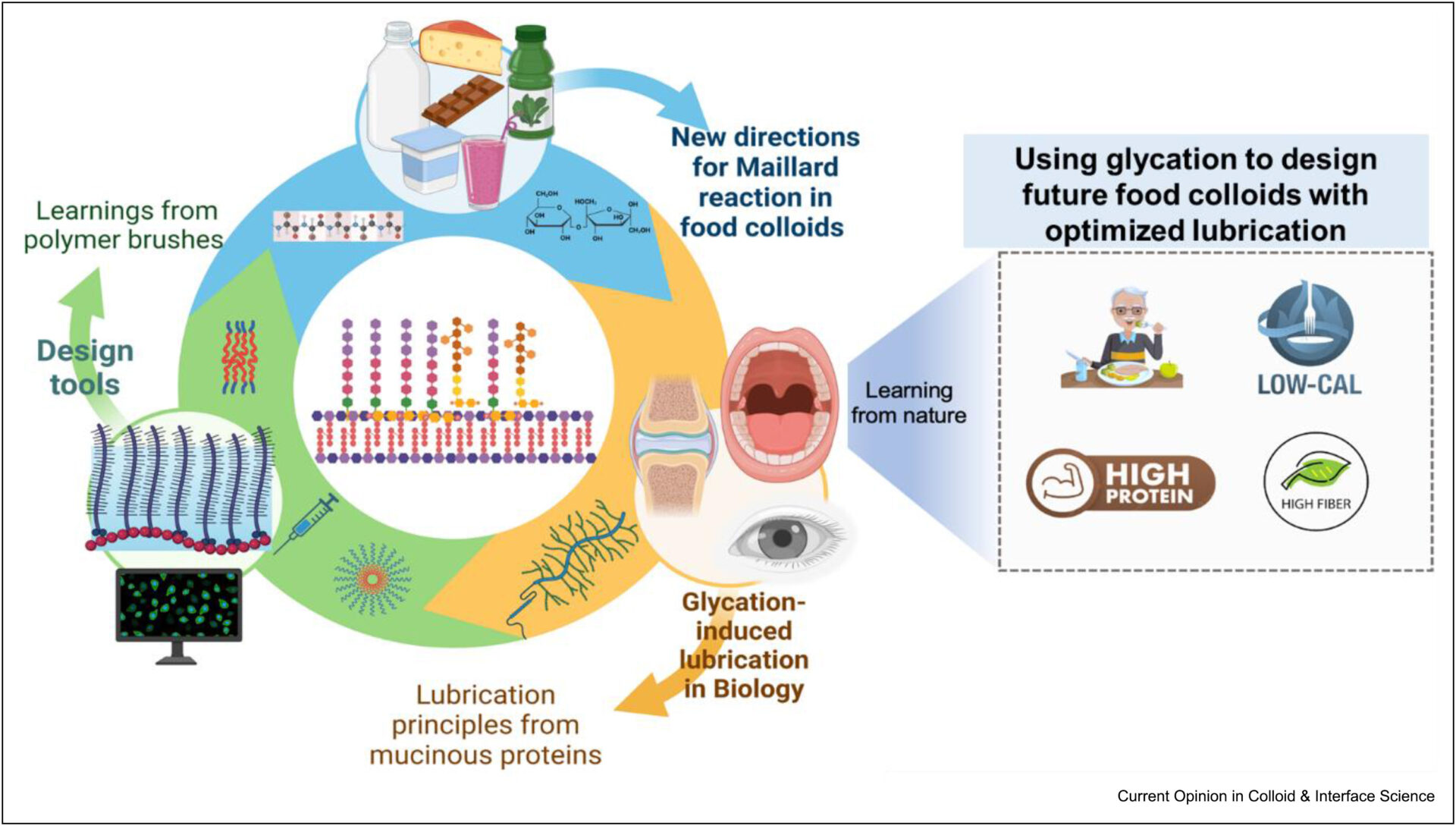
Figure 1. Illustration summarizing the essence of this review—unveiling insights from "glycation-induced lubrication" in nature and applying design rules from polymer physics for brush-led lubrication.
The understanding of glycation's role extends beyond conventional health considerations to encompass its contributions in biological systems. Glycation unfolds a fascinating narrative in nature, significantly impacting the structural and functional aspects of proteins. Venturing into the tribological realm, the focus shifts towards the lubricating properties inherent in glycated systems. Natural lubrication, a critical facet in biological fluids, takes center stage as glycan-mediated hydration lubrication is dissected. The molecular intricacies of prominent examples, such as lubricin and mucins, are explored, revealing the profound influence of glycosylation on tissue-lubricity. Shifting the focus to food science, current studies on glycation in food colloids are highlighted. Examples include fish gelatin glycated with gum Arabic and whey protein conjugated with dextran. The ramifications of glycation on lubrication performance within food systems are unravelled, providing a profound understanding of the potential applications of this phenomenon in the development of sustainable and health-conscious foods.
Finally, potential future uses of glycation in the design of food colloids are discussed particularly for alternative proteins. Chain length, charge density, and processing conditions are crucial to final tribological properties of glycated alternative proteins. This comprehensive review reveals the rich tapestry of glycation, weaving together its various roles in biology and food science, and laying the groundwork for future research and application in sustainable food design.
New paper titled "Difference in astringency of the main pea protein fractions" published in Food Hydrocolloids
As we transition towards more sustainable, healthier and alternative plant based diets we must understand the consequences of their often negatively perceived sensory attributes. Plant proteins are often found to be dry, unpleasant and astringent – the latter meaning a puckering, shrinking like dryness in the mouth (similar to an over-brewed cup of tea). The result is that dairy (such as whey and milk protein) and meat proteins are more favourable in comparison in consumption as a protein. The astringency phenomenon is still debated but is thought to be a result of interactions between plant proteins and salivary proteins causing precipitation and saliva lubrication failure, however exact mechanisms remain elusive.
This investigation into plant protein astringency published in Food Hydrocolloids (https://doi.org/10.1016/j.foodhyd.2023.109489) focused on non-allergenic pea protein as a popular upcoming alternative protein found as high protein powders and in high protein vegetarian/vegan foods. Three questions were asked 1) do different fractions of pea proteins have different astringency perception, in other words are globulin fractions more astringent than the albumin fraction? 2) is there a correlation between sensory astringency and oral friction or adsorption? 3) do the salivary protein-plant protein complexes vary depending upon the protein type? To understand these questions, we investigated the astringency levels of the three main pea protein fractions (legumin-rich, vicilin-rich and albumin-rich fractions) and combined in vivo sensory analysis, in vitro analysis of the pea fractions on salivary lubrication (saliva collected ex vivo), protein adsorption on ex vivo salivary conditioning film-coated surfaces and protein proteomics. Sensory analysis showed that all three-protein solutions were perceived as astringent, but the level of astringency of the solution containing the albumin fraction was significantly higher when compared to the solutions containing the other protein fractions.
Interestingly In vitro measurements in soft-tribology showed that all three-pea protein fractions induced a comparable but significant loss of salivary lubrication. Proteomics analysis highlighted the existence of a common pool of salivary proteins interacting in a non-specific way with all three pea protein fractions. Salivary glycoproteins (MUC 7 and MUC5B), well known to be involved in the maintenance of viscoelastic and lubricating salivary properties, were identified in this pool of salivary proteins. This brings us to hypothesise that the basal level of astringency perceived in all pea protein fractions is a lubrication breakdown process

Figure 1. Plots of mean friction coefficient (μ) as a function of entrainment speed (m.s−1) determined between ball and disc, both surfaces made by PDMS, at 2N load in presence of protein solutions at 0.5% (w/v) for a) legumin-rich b) vicilin-rich c) albumin-rich fractions respectively. The same friction curves of HEPES buffer () and whole human saliva () are represented in all the graphs.
It was QCM-D results that proved pivotal in understanding why albumin fraction appeared more astringent, which significantly interacted more forming a thicker, more rigid film on a salivary pellicle compared to the vicilin-rich and legumin-rich fractions potentially indicating a more adverse interaction with saliva.

Figure 2. Plots of a) hydrated mass and b) –ΔD/Δf obtained (5th overtone) for 2.0 mg/mL protein suspensions (legumin-rich, vicilin-rich, albumin-rich fractions).
The proteomics results showed that the albumin-rich fraction induced the precipitation of a higher number of salivary proteins. By comparing the pea-protein/saliva-protein precipitates for all three-pea protein fractions, we could identify subsets of proteins unique to the precipitate of the albumin-rich fraction. This subset contained many salivary proteins (n = 63) but only 13 pea proteins, strongly suggesting the existence of specific and strong interactions between the 13 pea proteins (or a subset of these 13 pea proteins) and the salivary proteins (or a subset of these proteins). The 13 proteins are all part of the secondary metabolism of the plant and many of them are involved in defence mechanisms (i.e. antifungal and antibacterial). We postulate that these proteins have the ability to interact with foreign proteins and thus end up interacting with a number of salivary proteins. These extra interactions could be the cause of the perceived increase in astringency for the albumin-rich fraction. The extra astringency of the albumin-rich fraction may occur due to the unique interactions of this fraction with the salivary pellicle layer, which suggests a different mechanism that we have not identified. This multifaceted approach paves the way for further in-depth studies of plant proteins, identifying primary causes of poor sensory performance and potential solutions in creating improved alternative protein products in the future
New paper titled "Fabrication and lubrication performance of sustainable Pickering-like water-in-water emulsions using plant protein microgels" in NanoSelect
Aqueous multiphasic systems have attracted a great deal of interest recently owing to the growing demands of sustainability for the development of stable “oil-free” emulsions, often complicated by their limited stability against droplet coarsening. Although particles may provide ultrastability to water-in-water (W/W) emulsions formed in phase-separating polymer systems, the need for lubrication in such W/W emulsions presents an important challenge for their use in diverse applications. In this paper published in Nano Select https://doi.org/10.1002/nano.202300160 , W/W Pickering emulsions were stabilized by sustainable plant protein (pea)-based microgels (PPM) using starch and xanthan gum as the biopolymers to generate the W/W phase separating droplet structures. The lubricity of these systems was compared with that of parallel systems stabilized by animal (whey) protein microgels (WPM). New results reveal that PPM are more soft and adhesive than WPM and outperform the latter in boundary lubrication performance, in striking contrast to the behavior of the non-microgelled pea or whey proteins (Figure 1) . Using a comprehensive suite of multiscale techniques, including microscopy, light scattering, rheology, tribology, and surface adsorption measurements, we have demonstrated two key findings.
- Soft proteinaceous microgels, made from two very different protein sources (pea and whey), can both stabilize Pickering-like water-in-water (W/W) emulsions, though with different morphologies (Figure 2) and bulk viscosities.

Figure 1. Structure and performance of microgels in the bulk phase. Topogrphic images of microgels, as obtained by AFM for WPM (A1) and PPM (B1). Histogram plots showing the particle size distributions for WPM (A2) and PPM (B2). Mean frequency shift (Δf,─) and dissipation change (ΔD,─) are obtained using QCM-D for 0.05 vol% WPM(A3) and PPM (B3). Mean apparent visosities (η) versus shear rate (𝛾), and Mean friction coefficient (μ) versus entrainment speed (U) of WPM (blue) and PPM (green) are shown in (C).
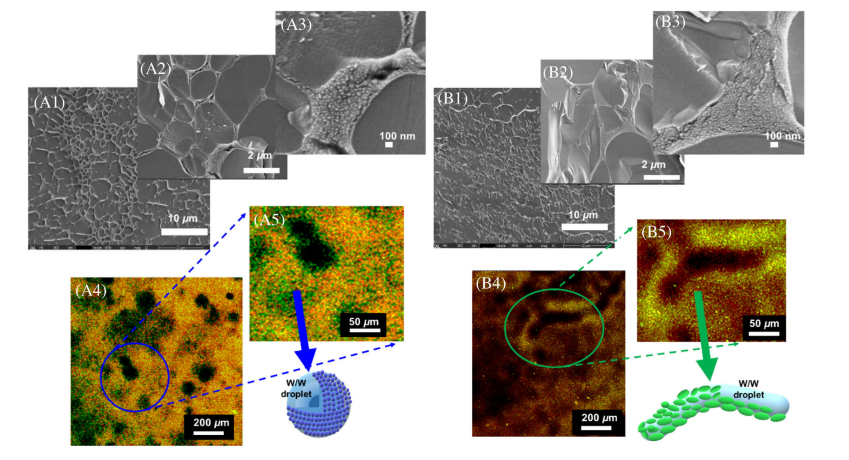
Figure 2. Microstructure of W/W emulsions. Cryo-SEM images at different magnifications of 2.0 wt% GS+0.2 wt% XG W/W emulsions with WPM (A1-A3) and PPM (B1-B3). CLSM micrographs at two different magnifications of the same systems with WPM (A4 andA5) WPM and PPM (B4 and B5) are also shown.
2. Sustainable plant-based (pea) protein microgels outperform the animal (whey) protein microgels in terms of lubricity on their own (Figure 1) as well as the lubricity of the microgel-laden W/W emulsions. Strikingly, the microgel and microgel-stabilized-W/W emulsion performances are in sharp contrast to the behavior of the parent proteins, where pea protein is known to result in increased friction as compared to whey protein (Figure 3).

Figure 3. Mean friction coefficient (μ) versus entrainment speed (U) of lower concentration (square) with 1.0 wt% GS and 0.1 wt% XG and higher concentration emulsions (triangle) with 2.0 wt% GS and 0.2 wt% XG; GS (Black), XG (purple), emulsion (red), and WPM-loaded emulsion (Blue), and PPM-loaded emulsion (green), with magnified graph on boundary regime.
Such differences are attributed to the increased size, lower viscoelasticity, enhanced degree of adsorption, and enhanced adhesive properties of the PPM as compared to the WPM. In turn, these microgel differences lead to different morphology of the corresponding Pickering emulsions, the PPM leading to more distorted, less spherical water droplets which are possibly more easily entrained within the tribological gap. These novel insights pave the way forward for designing water-based sustainable bio-lubricants from plant proteins which should have applications in food, pharmaceutical, personal care and allied sectors.
New paper titled "Tribology and rheology of potato protein and pectin mixtures and Maillard conjugates" published in Sustainable Food Proteins
High greenhouse gas emissions associated with the animal-sourced foods necessitate a shift from an animal protein-based diet to a plant protein-based one. Such shift aligns with the UN's sustainable development goals and can simultaneously reduce the prevalence of diseases linked with over-consumption of animal sourced foods, e.g. cardiovascular disease. Plant proteins are currently projected as one of alternative dietary protein sources to conventional animal proteins due to lower environmental footprints. However, plant-sourced foods often have unfavourable attributes such as undesirable flavour or dry mouthfeel perception limiting their consumer acceptance rate. Some of those attributes associate with high oral friction of plant proteins. We envisaged that one approach to tackle high friction of plant-proteins can be addition of a suitable polysaccharide and modifying the mouthfeel. This work tiled ‘Tribology and rheology of potato protein and pectin mixtures and Maillard conjugates" published in the journal of Sustainable Food Proteins t’, DOI: https://doi.org/10.1002/sfp2.1018 demonstrates how Maillard reaction of plant proteins with polysaccharides can be used modify tribological performance of plant proteins.

In the work, we used potato protein (Po) which is a promising protein source for human consumption due to its high digestibility, non-allergic characteristics and techno-functional properties (e.g. water-solubility, gel-forming, foaming, emulsifying). For the polysaccharide source, we selected pectin (Pe) which has promising water-retention, gelling capacity as well as favourable viscous and lubrication properties. The tribological and rheological measurements were conducted to investigate the friction and flow behaviour of the sole Po or Pe solutions, their mixtures and their Maillard conjugates. Pe solutions demonstrated excellent viscous lubricity (Figure 1) as compared to limited lubricity of Po solutions. As shown in Figure 1, Pe enhanced the lubricity of Po solutions and dominated the lubrication behaviour in Po + Pe mixtures, governed mainly by the concentration of Pe and the hydrodynamic volume rather than the total concentration of the biopolymers.
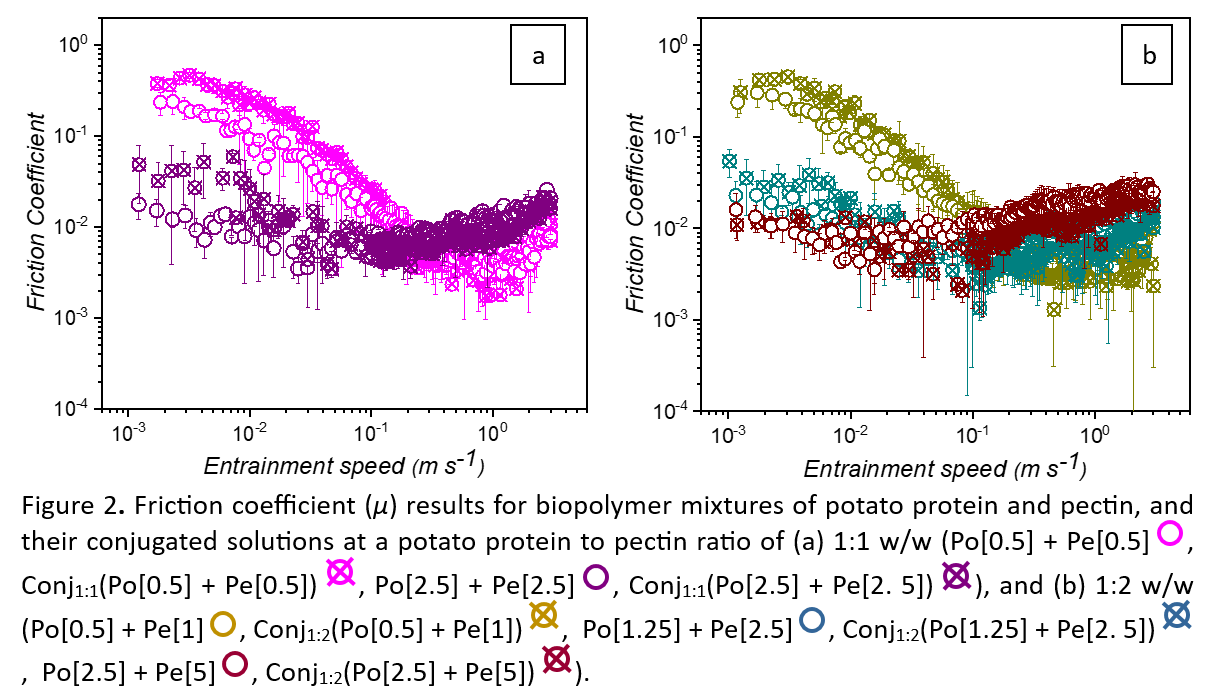
However, upon increasing the concentration of Pe in the conjugates (lower Po:Pe ratio of 1:2), the slight difference in lubricity between mixtures and conjugates disappeared and conjugates at Po:Pe ratio of 1:2 w/w showed consistently comparable (p > 0.05) friction behaviour to those of the corresponding mixtures (Figure 2). The degree of conjugation was increased from 19.7 ± 1.9 % at the Po:Pe ratio of 1:1 w/w to 32.8 ± 1.7 % at the Po:Pe ratio of 1:2 w/w. This evidenced the obvious benefits of conjugation of Po with Pe at high degrees of conjugation on lubrication properties and structural stability of the Po + Pe mixtures and Po solutions. The consistency with the lower Po:Pe ratio (i.e. higher degree of conjugation) implied a more effective interaction between PDMS and conjugated biopolymers or adsorption at the contact interface. The findings from this feasibility study may inspire future work on using conjugation to create new ingredient building blocks to produce sustainable plant-based food products with desirable textural attributes, which needs validation by sensory evaluation.
New paper titled "Transforming sustainable plant proteins into high performance lubricating microgels" published in Nature Communications
Imagine food consumption throughout our history, let’s say 100 years ago? Compare this to the food that we eat today. The developed world currently lives in a period of vast food choices. In past centuries, sweets, meats, herbs, spices and complex food formulations were only for minority of the population in specific regions of the world. However, in modern day we do not even have to get out of our beds to order thousands of such foods delivered straight to our door. In our naivety a crisis has emerged. Climate change and global warming are causing havoc in modern infrastructure with our food choice playing a significant role in emission production.
Food accounts for one third of human-made greenhouse gas emissions (GHGs) with animal foods in particular contributing to 57% of those GHGs. Additionally, with an increasing population, particularly with a shift in demographics towards older adults, current protein production will strain in years to come. The consequences are being seen today and so this raises the question, what will our food look like in 10 years or let’s say 50 years from now? We must focus towards developing an environmentally responsible, sustainable and efficient consumption of food and one thing is for certain, plant proteins will play a pivotal role in developing this sustainable food system for the future. Obviously, today we see a boom in plant protein-based foods, directly as meat analogues or their use as ingredients and in protein-fortified foods. The intention is not only to support the planet but also to contribute to protein equity and distribution across the globe whist achieving animal welfare. Despite this boom, transitioning to more plant protein-based diets are low, but why is that?
Fundamentally, plant proteins suffer with poor functionality such as limited solubility as well as poor organoleptic properties in taste (i.e. bitterness, beany) and texture, particularly astringency. These traits certainly do not help food manufacturers in successful design of plant protein-rich foods, yet alone convince the consumers to switch. In fact, Sarkar Lab did a tasting trial (Figure 1) of nearly all plant protein-based commercial products available in the UK supermarket and we found them to be rather undesirable and not comparable to meat or dairy by any means.

Figure 1. Team tasting of commercial plant-based food products.
So what is missing? In taste, much focus has been undertaken to mask off flavours, often ultra-formulation approaches have been used with addition of higher fat, sugar, salt and other additives that reduces their healthiness potential. What has been overshadowed however is the undesirable texture, such as astringency that is often termed as “dry”, “non-juicy”, “gritty” in various plant protein-based formulated foods. These perceptions are mechanosensations that are hypothetically linked to raising oral friction or lubrication failure. In this paper published in Nature Communications, Volume 14, Article number: 4743, https://doi.org/10.1038/s41467-023-40414-7, we have converted these poorly lubricating plant proteins into ultralubricating, hydrated structures called “microgels” to relieve poor textural performance.
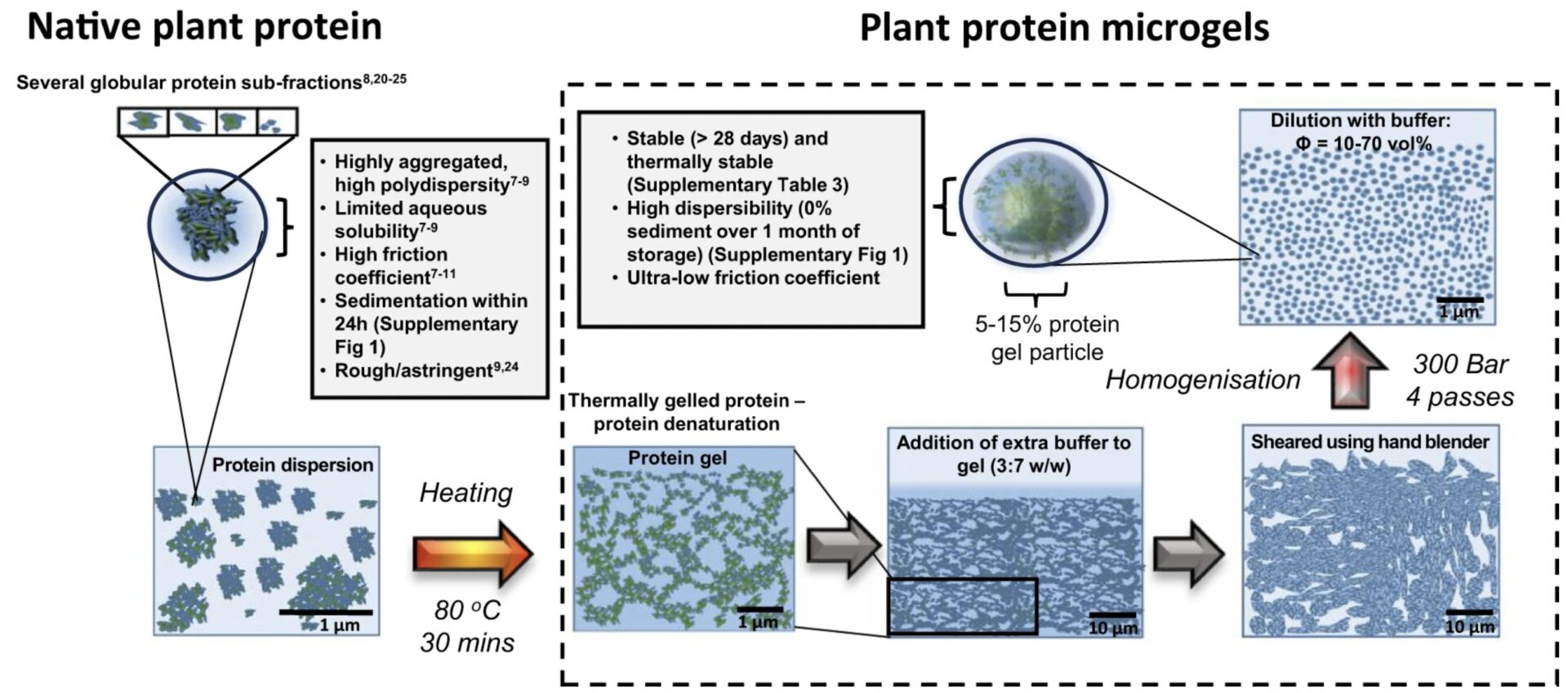
Figure 2. Microgelation process.
The most exciting element is that we do add any harsh processing to create these microgels and utilise unit operations that are fairly common in any food manufacturing premise.
So, what are these microgels? Microgels are like sponges of water that are connected via a web-like network of proteins, a water-hydrated blob. How do we make them? Firstly, plant proteins are hydrated and then gelled under heat – thanks to the hydrophobic and thiol groups present inherently in the protein allowing natural croslsinking. Finally, we shear these gels to form these microscospic sponge-like hydrated plant protein particles containing > 85% water – a microgel (Figure 2). What is remarkable is the unprecedented functionality and lubrication performance of these new particles that we show in this paper by combining theoretical and experimental studies. Firstly we characterised these particles measuring size and shape using atomic force microscopy (AFM) (Figure 3a) where we found that these microgels were spherical and sub-micron-sized. These microgels displayed excellent dispersibility and stability especially compared to native proteins (Figure 3b) with no size change upon heating or storage.

Figure 3. Overview of microgel performance. Atomic force microscopy (AFM) on plant protein microgels (a). Dispersibility and stability of native vs microgel protein (b). The excellent lubrication properties of microgels vs native protein vs O/W emulsion (c). Lubrication measured using new biomimetic tongue surfaces (d).
Next, what was remarkable was that these microgels provided orders of magnitude reduction in friction compared to native proteins of same protein concentration. This was shown both in low concentrations as well as high concentrations of the microgels no matter the protein type. Now, we further compared the lubrication against a well-known lubricating food, a 20% oil in water (O/W) emulsion, resembling single cream as a challenge. To our surprise, the plant microgels which contained no lipidic additives mimicked the lubrication performance of these O/W emulsions (Figure 3c). To further confirm such findings we also compared lubrication utilising a new biomimetic tongue-like surface, latter is a more representable surface (topography, elasticity and wettability) to our own tongue, and the outstanding lubrication results of plant protein microgels persisted (Figure 3d). Therefore, these microgels serves dual roles by making plant proteins more palatable in tactile context and reduces any formulation additives.
Finally, considering that we do not add anything except structuring the plant proteins with water, why do microgels behave so brilliantly? Combining theoretical models and indentation theory, we were able to demonstate that these microgels are able to support high loads due to their viscosity – acting as mini reservoirs of water. When squeezed under load, let’s say sheared between tongue and palate in the mouth, this encapsulated water weeps increasing localised viscosity enhancing hydration lubrication between surfaces.
In summary, using well-established physical processing techniques, we are able to create highly stable, dispersible and heat resistant plant protein microgels that reduce friction by orders of magnitude in comparison to the original native protein with comparable lubrication performance to those of creams. Next, the question is can these microgels behave like fat droplets in mouth sensorially? How do they perform in food product matrices? – this still needs to be answered. Once we answer these, microgels can be a game-changing ingredient technology in sustainable food design.
New paper titled "Insights into the Multiscale Lubrication Mechanism of Edible Phase Change Materials" published in ACS Applied Materials and Interfaces
Investigation of alubrication behaviour of phase change materials (PCM) can be challenging in applications involving relative motion, e.g., sport (ice skating), food (chocolates), energy (thermal storage), apparel (textiles with PCM), etc. In oral tribology, a phase change often occurs in a sequence of dynamic interactions between the ingested solid PCM and oral surfaces from a licking stage to a saliva-mixed stage at contact scales spanning micro- (cellular), meso- (papillae), and macroscales. Often the lubrication performance and correlations across length scales and different stages remain poorly understood due to the lack of testing setups mimicking real human tissues. In this paper published in ACS Applied Materials & Interfaces (2023, Volume 15, Issue 3, Pages 3699–3712), the multi-scale lubrication performance of chocolates (as a model food PCM) at a single-papilla scale and a full-tongue scale was investigated, the latter using the tongue-mimic materials developed earlier at Sarkar Lab (https://pubs.acs.org/doi/10.1021/acsami.0c12925). The complex eating process for a solid chocolate, can be broken down into primarily three stages, which are referred to as licking stage (Figure 1.A), molten/initial mastication (Figure 1.B), and bolus (saliva-mixed) before swallowing (Figure 1.C). We developed and used a tribo-microscopy setup, equipped with a florescent microscope, to visualise and understand the in situ tribo-flow behaviour of chocolates (in molten and boli states) at the single-papilla scale (Figure 1).
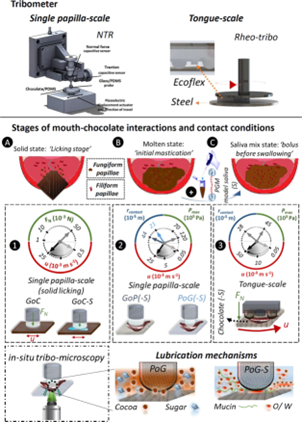 |
| Figure 1. Schematic illustration of the tribological setup across scales and three stages of (A) licking, (B) molten, and (C) saliva-mixed. The schamitic of the tribo-microscpoy setup and observed lubrication mechanism at molten and saliva-mixed stages are shown at the bottom of the figure. |
The tribo-microscopy results coupled with confocal microscopy observations (Figure 2) confirmed the confinement of solid cocoa particles between papilla and palate in the molten stage, and coalescence of oil droplets and interposition of the droplets at the papilla interface in the saliva-mixed stage (Figure 1).
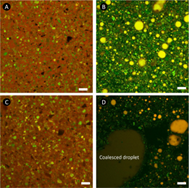 |
| Figure 2. Microstructural evolution of chocolates on triboshearing. (A, B) Confocal images of pristine 90% chocoa chocolate (90% C) and 90% cocoa chocolate-Saliva (90%-S) samples, respectively. (C, D) Post-triboshear structure of pristine 90% and 90%-S samples, respectively. The green particles, black angular voids, and red continuous phase show solid cocoa particles, sugar particles, and fat matrix, respectively. The orange-red and green contrasts represent the fat droplets and the solid cocoa particles dispersed in the black aqueous phase, respectively. The white scale bars in the images represent 20 μm. |
Unprecedented results from this study supported by transcending lubrication theories reveal how the tribological mechanism in the licking stage shifted from solid fat-dominated lubrication (saliva-poor regime) to aqueous lubrication (saliva-dominant regime), the latter resulted in increasing the coefficient of friction by at least threefold (Figure 3.A1). This showed the excellent fat-driven solid-lubricity of chocolates and indicated that high fat at the surface of chocolates can improve its textural perception. At the single-papilla scale, the governing lubrication mechanisms were bridging of cocoa butter in between confined cocoa particles and fat coalescence of emulsion droplets for the molten (Figure 3.A2) and saliva-mixed (Figure 3A.3) stages, respectively. At the tongue scale, a distinctive hydrodynamic viscous film formed at the interface governing the speed-dependent lubrication behaviour (Figures 3A.4 and 3.A.5). New tribological insights across different stages and scales of phase transition from this study reveal that location of fat is highly important as compared to fat content, which is rarely studied and such mechanistic insights will inspire rational design of the next generation of PCM and solid particle-containing materials. Based on our observation, we hypothesised a design strategy for healthy creating healthy chocolates with a gradient fat deposition (Figure 3.B).
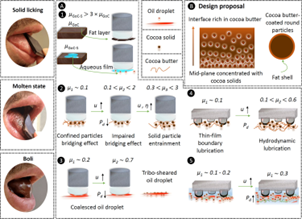 |
| Figure 3. (A) Summary of multiscale lubrication mechanisms of chocolates at licking, molten and saliva-mixed stages and (B) proposed design of tribology-informed future fat-reduced dark chocolates. |
New paper titled "Flaxseed oleosomes: Responsiveness to physiochemical stresses, tribological shear and storage" published in Food Chemistry
Oleosomes, also known as oil bodies, are micron-sized, micelle-like organelles found in the nature that serve as intracellular lipid storage structures. They possess a distinctive composition, consisting of a hydrophobic triglyceride core surrounded by phospholipids and various embedded alkaline proteins, including oleosins, caleosins, and steroleocins. In this study published in Food Chemistry (https://doi.org/10.1016/j.foodchem.2023.137160), oleosome samples were extracted from flaxseed using a facile, green, aqueous extraction method under low temperature and pH close to natural conditions, with no addition of organic solvents. The oleosomes were stabilized by a range of lower to higher molecular weight proteins including ones hypothesised to be associated with mucilages. Using a combination of microscopy across length scales, electrophoresis and light scattering, we confirmed, for the first time, the kinetic stability of these oleosomes stabilized by proteins of 3.5– 152.8 kDa over 6 weeks storage. This stability can be largely attributed to electrostatic repulsive forces generated by the flaxseed proteins, whilst steric stabilization was offered by larger glycans associated with mucilage. Varying degree of kinetic stability was evidenced in presence of ions and pH conditions with most dramatic effects of coalescence observed in presence of Ca2+ ions due to ion binding to oleosome-associated surface proteins. Strikingly, the oleosomes show a high shear thinning behaviour despite containing just 6 wt% oil. Of more importance, the unprecedented tribological properties of flaxseed oleosome was similar to those of flaxseed oil highlighting the shear-induced coalescence of these oleosomes forming a load-bearing film. In summary, this study sets the scene for using flaxseed oleosome as a potential natural emulsion for designing plant-based products without added emulsifiers to offer the desired rheological as well as tribological benefits. Future studies are underway exploring the sensorial and gastrointestinal digestion of these naturally derived emulsions.
152.8 kDa over 6 weeks storage. This stability can be largely attributed to electrostatic repulsive forces generated by the flaxseed proteins, whilst steric stabilization was offered by larger glycans associated with mucilage. Varying degree of kinetic stability was evidenced in presence of ions and pH conditions with most dramatic effects of coalescence observed in presence of Ca2+ ions due to ion binding to oleosome-associated surface proteins. Strikingly, the oleosomes show a high shear thinning behaviour despite containing just 6 wt% oil. Of more importance, the unprecedented tribological properties of flaxseed oleosome was similar to those of flaxseed oil highlighting the shear-induced coalescence of these oleosomes forming a load-bearing film. In summary, this study sets the scene for using flaxseed oleosome as a potential natural emulsion for designing plant-based products without added emulsifiers to offer the desired rheological as well as tribological benefits. Future studies are underway exploring the sensorial and gastrointestinal digestion of these naturally derived emulsions.
New paper titled "Frictional behaviour of plant proteins in soft contacts: unveiling nanoscale mechanism" published in Nanoscale Advances
Nanotribology using soft colloidal probe offers working with extremely low (∼nN) normal forces giving access to focus on a regime such as the tongue papillae (∼μm), to better understand its role on the overall frictional dissipation of the oral cavity. This study published in Nanoscale Advances (https://doi.org/10.1039/D2NA00696K) covers a detailed investigation of frictional behaviour of sustainable plant proteins at the nanoscale for the first time, using deformable bio-relevant surfaces that achieve biologically relevant contact pressures. The study gives study with unprecedented understanding of the dynamics when a plant protein moiety encounters a single papilla in a tongue rather than the entire tongue.
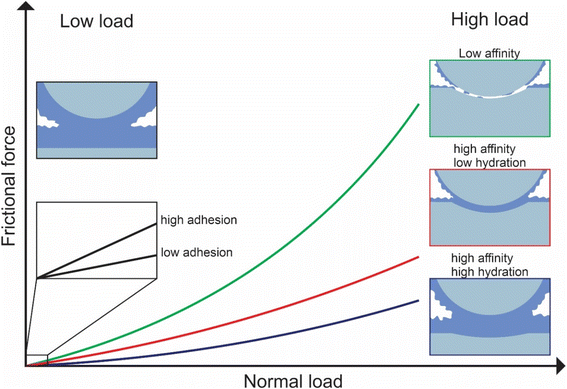
As shown in the schematic figure, we confirm that protein affinity towards a given substrate is essential to ensure good lubricating properties of proteins. Having achieved sufficient adsorption, the degree of hydration of the adsorbed film becomes crucial since it reduces friction. Besides these two factors, surface interactions between the two protein-coated surfaces chiefly govern the lubricating performance of plant proteins at low loads since the adhesive forces between bodies are comparable to the observed friction force. It is also possible that at low loads surface roughness is another factor affecting friction, with increased roughness caused by the plant protein aggregates having increased friction, however, further investigation is needed to investigate roughness effects.
Although proteins with high affinity can have good lubricating properties even if the film is poorly hydrated, the opposite is not true; a highly hydrated film may not have superior lubricating properties unless the affinity towards the surface is not sufficient to maintain the film on the surface upon sliding. This was highlighted in the case of mucins where a highly hydrated film with poor affinity had very poor lubricating properties. However, upon combining mucins with plant proteins, which is much more representative of physiological conditions where the inner epithelium is coated with a mucosal layer, the resulting plant protein-mucin film has superior lubricating properties since it combines the high affinity of the plant proteins with the high hydration of BSM. However, at higher loads, many, if not most, plant proteins experienced a higher friction coefficient due to dehydration and protein removal caused by sliding. Generally, an increase in ionic strength increases hydration since protein can hold more water molecules due to an increased number of ions, while it also increases affinity towards the surface. As a result, the protein film becomes more resistant to dehydration and hinders protein removal caused by sliding. However, it could also lead to the formation of larger aggregates, which are jamming the contact thereby increasing friction coefficient.
In particular, among the tested proteins, pea protein seems to stand out in its lubrication performance as compared to lupine and potato, driven by an increased affinity towards the hydrophobic PDMS surface and a more hydrated protein film that aids lubrication. Although the trend is similar to what has been observed previously in macroscopic frictional response particularly at low protein concentrations as used in the current study, the differences in frictional behaviour of plant protein types are far more significant at the nanoscale owing to single papillae-level resolution and clear molecular mechanism behind such behaviour is laid out for the first time. The current work offers novel insights into the nanotribological performance of plant proteins pinpointing the role of adhesion, affinity and protein hydration as well as load dependency, that can be tuned either by plant protein type or subtle manipulation of environmental factors (pH, ionic strength) and holds great potential for future development of sustainable food and biomaterials where optimum lubrication is a key necessity.
New paper titled "Tribology and rheology of water-in-water emulsions stabilized by whey protein microgels" published in Food Hydrocolloids
Water-in-water (W/W) emulsions are thermodynamically incompatible solutions of two biopolymers. Such emulsions demonstrate phase separation, producing water droplets being richer in one biopolymer phase than the other. Although the design principles and formulation strategies of W/W emulsions have been well-researched, very little is known about the mechanical performance of W/W emulsions, which is crucial if such emulsions are to be used in food applications and eventually such emulsions are consumed and undergo oral processing. Oral processing involves a dynamic range of deformation in a relatively short span of time that can be assessed using rheological and tribological analysis to understand the bulk and surface effects, respectively. In this study (https://doi.org/10.1016/j.foodhyd.2022.108009), published in the journal of Food hydrocolloids, the aim was to investigate the microstructural, tribological and rheological properties of water-in-water (W/W) emulsion droplets with or without stabilization by proteinaceous microgel particles.
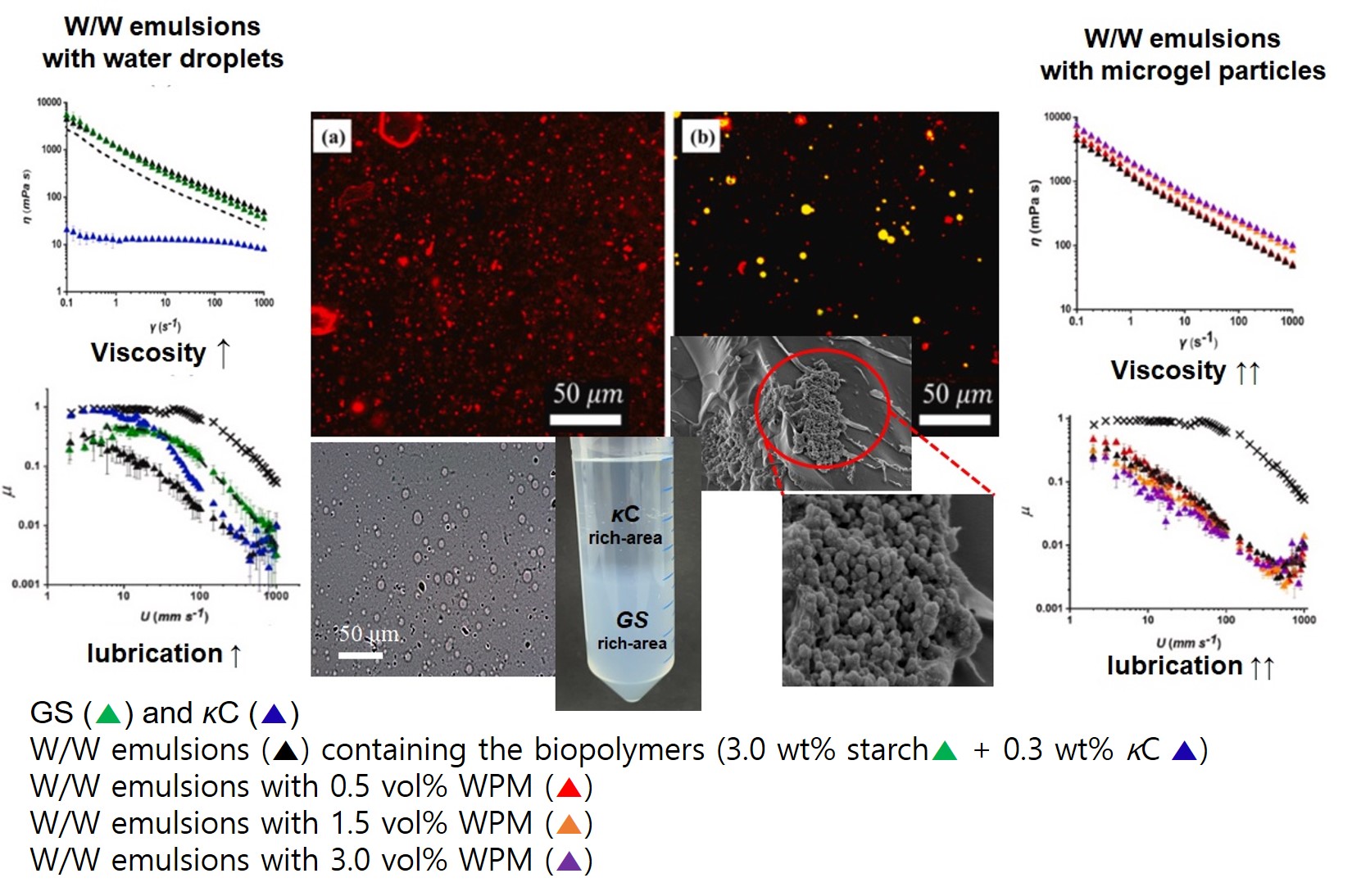
The W/W emulsions were prepared from mixtures of gelatinized corn starch (GS) and κ-carrageenan (κC) in the two-phase regime and when designing particle-stabilized emulsions, whey protein microgel particles (WPM) were used. The W/W emulsions were shear thinning liquids. The viscosity values of the emulsions were higher than the corresponding weight average values, calculated on individual biopolymers irrespective of shear rates confirming the colloidal droplets generated. Tribological results revealed that, unlike the corresponding biopolymer solutions of GS and κC , W/W emulsions containing the two biopolymers (3.0 wt% GS + 0.3 wt% κC) decreased μ in the mixed and boundary regimes, probably due to accretion of water droplets into a hydration film between the tribological contact surface under the tribological stress. In the case of W/W emulsions containing WPM, confocal and cryo-scanning electron microscopy confirmed the presence of WPM at the interface and hence a Pickering-like stabilization. The WPM-stabilized W/W emulsions showed higher apparent viscosity (than those without WPM) and lower μ in the boundary and mixed regimes. To our knowledge, this is the first report that investigates the frictional properties of W/W emulsion systems with and without the addition of Pickering-like microgel particles. The findings should bring new knowledge to aid the design of low-calorie products containing water droplets without compromising their mouthfeel.
New paper titled "Comparison of oral tribological performance of proteinaceous microgel systems with protein-polysaccharide combinations" published in Food Hydrocolloids
Polysaccharides are often used as rheology modifiers in multiphasic food systems. Replacing polysaccharides with proteinaceous moieties that can deliver thickening effects, which is conventionally obtained with polysaccharides, improves the design of processed foods with clean labels. Proteinaceous microgels from whey protein isolate have attracted research attention as promising lubricating agents. However, it is unclear whether proteinaceous microgels can be used to replace polysaccharides in a tribological context. In this study, published in the journal of Food Hydrocolloids (https://doi.org/10.1016/j.foodhyd.2022.107660), we compared the flow and oral-tribological behaviour of Newtonian solutions of the polysaccharide dextran (D, 1-11 wt%) when combined with a dispersion of whey protein isolate (W, 1-13 wt%) or whey protein microgel (WPM, 41.7 vol%). We observed that the dispersions of WPM (41.7 vol%) deliver the same flow and viscous-friction behaviour to that of 5 wt% D and excel in thin-film lubricity. Therefore, we generated dispersion of WPM in W solutions at different concentrations and compared them to solutions of D (5 wt%) + W at comparable W concentrations. The concentration of W in free water (i.e. water content excluding D or WPM and its trapped water) was the same for a true comparison for each of pairs D[5] + W[1] and WPM + W[1]; D[5] + W[5] and WPM + W[3]; D[5] + W[11] and WPM + W[8]. As presented in Figure 1, this comparison showed that by optimising a combination of WPM and (non-microgelled) W, combined viscous and thin-film lubricity could be achieved through a single-component, i.e., whey protein, without the need of any polysaccharide. In this way, proteinaceous lubricants could be developed with no need for including a lipid or polysaccharide component but still meeting the satiety requirements. The another benefit of WPM + W combination as compared to D + W combination is improved thin-film lubricity especially across the mixed lubrication regime.
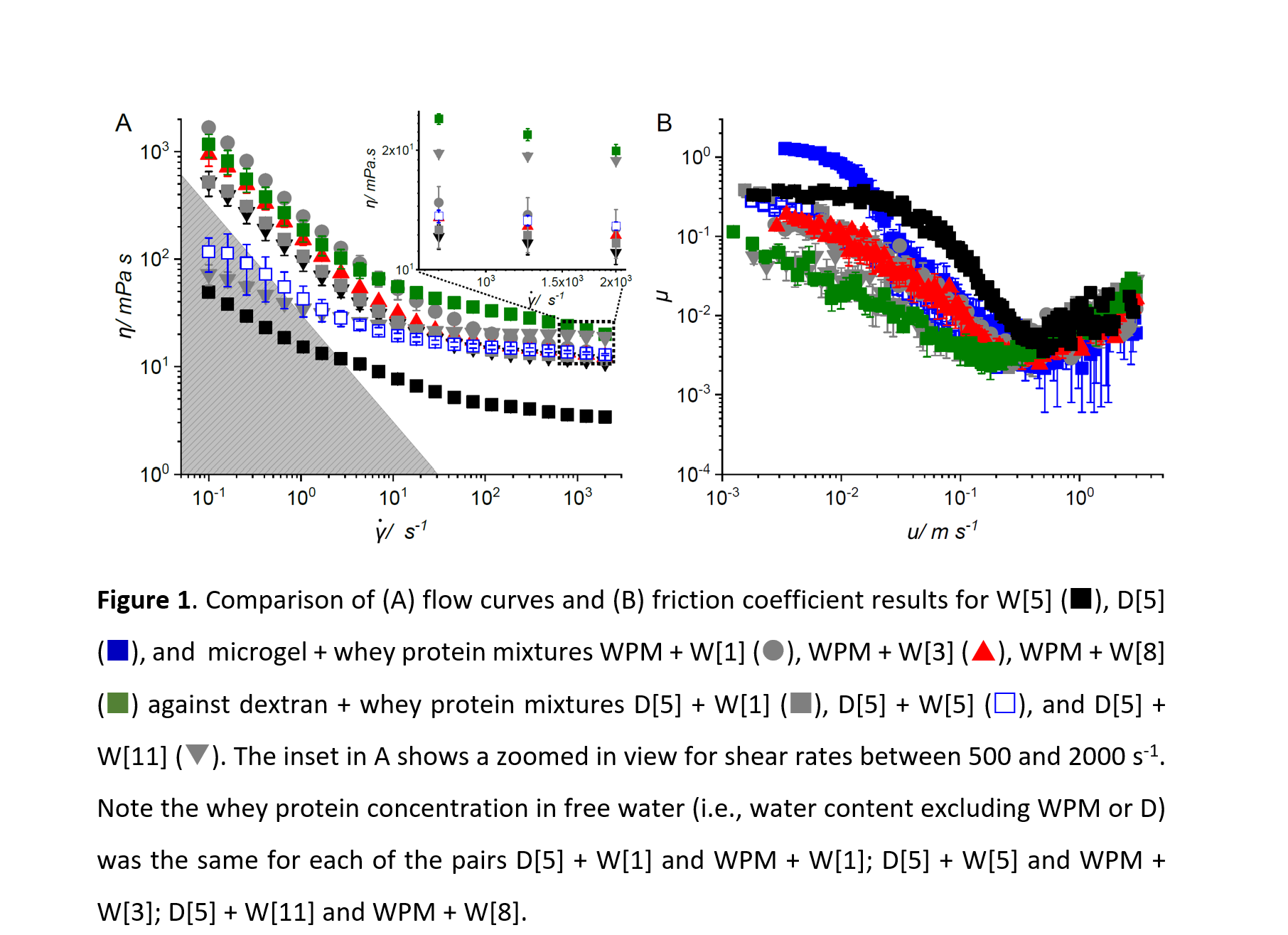
In order to further elucidate the mechanism of action of WPM in its mixtures with W, we plotted the friction against entrainment speed shown in Figure 1, as a function of reduced speed parameter, as shown in Figure 2. For Newtonian fluids with no apparent surface interactions (e.g. adsorption or bonding) or viscous-driven surface separation effects, the shear stresses at the contact surfaces are expected to be independent of the lubricant viscosity and the curves are expected to collapse into a single ‘master’ curve, shown as the solid grey line in Figure 2.
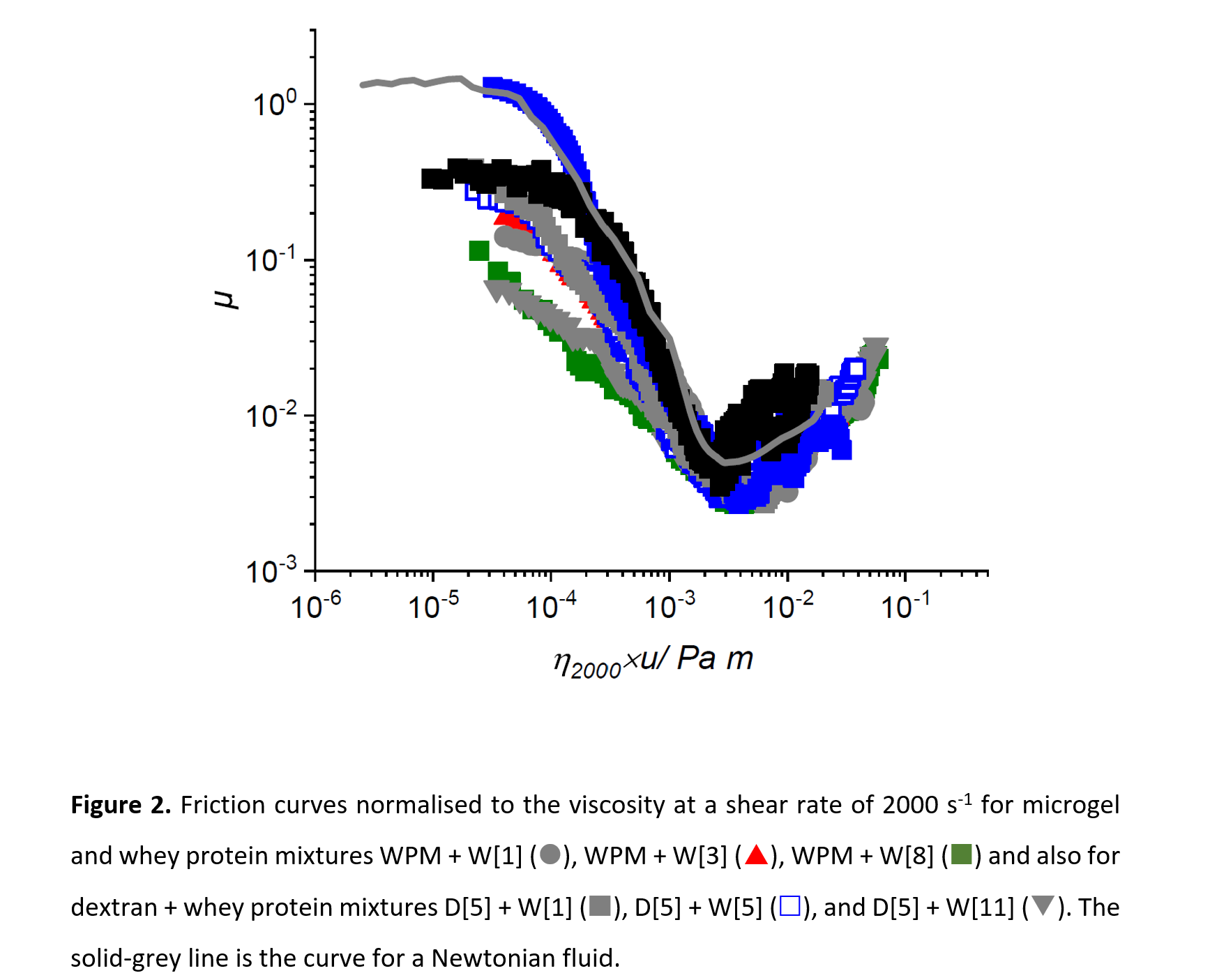
A similar coefficient of friction value in elasto-hydrodynamic (EHL) and hydrodynamic (HL) was observed for each of the compared pairs. Upon addition of WPM or D[5] to W[1] solutions, the absolute value of the characteristic tangent to the curve in the mixed regime decreased (Figure 2) with an increase in high shear-rate viscosity (see Figure 1). Further increase in [W] (i.e. WPM + W[3] and D[5] + W[5]) did not show a noticeable influence on the friction coefficient in the mixed regime (Figure 2) or on the results of high shear rate viscosities (Figure 1). The most distinct decrease in friction coefficient in the mixed regime was observed at the highest [W] (i.e. WPM + W[8] and D[5] + W[11]), coinciding with the largest increase in the high shear rate viscosity. We concluded that the viscous forces impede fluid squeeze-out and de-wetting of the contacts at the asperity level and therefore reduce the collision frequency between asperities.
Another important finding was reflected in our observation of a very similar friction behaviour for WPM and W[5] in the boundary lubrication regime and similar entrainment speed value for start of the EHL regime despite the fact that the high shear rate viscosity of the WPM was over three times larger than that of W[5]. To investigate this observation further, we estimated lubricant film thicknesses (hc) and the tribological shear rates values at the contact interface in the EHL regime as shown in Table 1.
Table 1. The calculated central film thicknesses at the contact interface (hc) and estimated shear rates in the EHL regime.
| Dispersions | hc (μm) | Est. shear rates (s-1103) |
| WPM | 3.071 | 61.872 |
| WPM + D[1] | 2.963 | 42.192 |
| WPM + D[5] | 3.791 | 16.486 |
| WPM + D[11] | 3.079 | 5.682 |
| Conj(D[11] + W[5])MG | 0.334 | 1.494 |
| WPM + W[1] | 3.327 | 56.512 |
| WPM + W[3] | 3.180 | 57.233 |
| WPM + W[8] | 2.872 | 33.081 |
* The EHL regime could not be accurately identified and a value of 0.001 was assumed.
We concluded that at a large / (dh is the hydrodynamic particle size) and relatively high shear rates, WPM and W[5] can show similar EHL behaviour. In other words, the impact of particles on the hydrodynamic forces are not significant and WPM can show lower viscosity values under extreme shear rate values taking place in tribological conditions, which may prompt shear-induced deformation or de-swelling (water loss). Further, the results obtained in Table 1, confirmed the particle entrainment in to the contact interface occur for all dispersions in the EHL regime.
In addition to that, we produced conjugates of W-D through Maillard reaction and converted them to microgels (Conj(D[11] + W[5])MG). The Conj(D[11] + W[5])MG showed superlubricity behaviour in the ball-on-disk measurements using a conventional tribometer (MTM2), where the lubricant film thickness was estimated to be of the order of the hydrodynamic size of the microgel particles. We hypothesized that this may be due to a cushioning lubrication mechanism where the contact bodies are fully separated by a closely-packed layer of microgels. On the other hand, the superlubricity of Conj(D[11] + W[5])MG was not evident in friction measurements with a tongue mimic surface that was tested using an adapted rheometer type apparatus (results presented in Figure 3).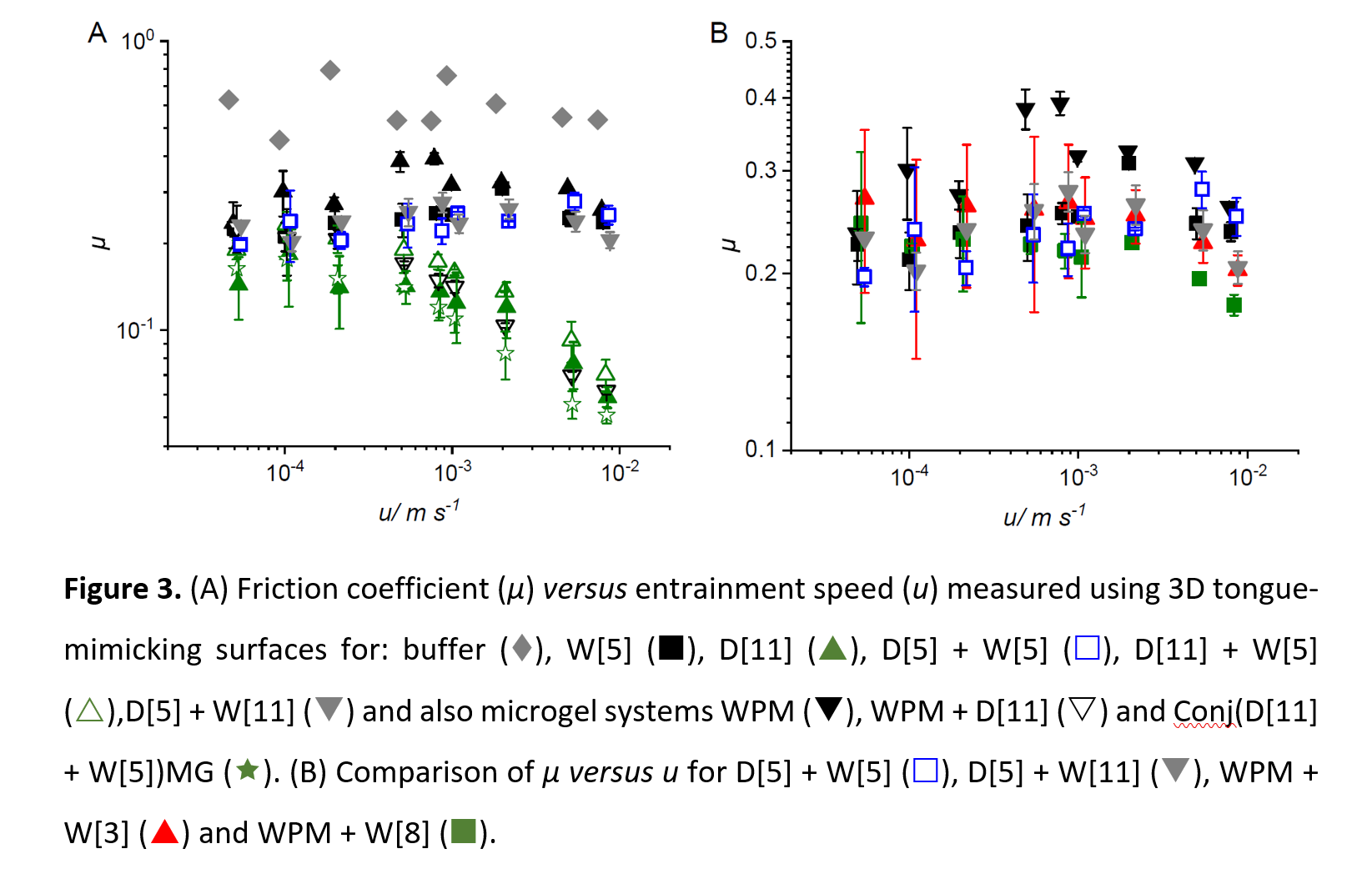
This was attributed to smaller separations between contact bodies and a lack of rolling contacts in the tongue-mimic setup. Results shown in Figure 3 confirmed that the in the setup using 3D-tongue micmicked elastomeric surfaces, the combinations of W and WPM should be able to provide desirable oral lubricity and mouth feel without resorting to combinations of polysaccharide additives and fat/oil dispersions.
New paper titled “Viscosity of food influences perceived satiety: A video based online survey" published in Food Quality and Preference
Food texture seems to offer a promising strategy for the control of expected satiety, satiety, satiation and daily caloric intake. In this study, published in Food Quality and Preferences, Volume 99 (Article No. 104565) https://doi.org/10.1016/j.foodqual.2022.104565, the aim was to examine the effect of food texture, more specifically the effect of different levels of viscosity on perceived satiety through an online survey where the viscosity levels of protein-based beverages were visually perceived using a newly developed video-based demonstration. Whey protein beverages were prepared with viscosities being manipulated using xanthan gum and their viscosity and tribological properties were measured instrumentally. Subjects (n = 211) watched beverages being poured in videos streamed online and were instructed to imagine drinking them followed by a list of questions related to perceived satiety and sensory perception. Figure below shows images captured from the videos.
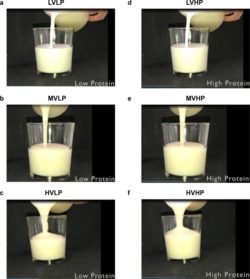
There were 3 levels of viscosity (low, medium and high viscous) and 2 levels of protein content (low and high). Participants were shown 6 videos with an average of 13 seconds each – LVLP (low viscous/low protein), MVLP (medium viscous/low protein), HVLP (high viscous/ low protein), LVHP (low viscous/high protein), MVHP (medium viscous/high protein) and HVHP (high viscous/high protein). In the figure below it can be seen that instrumentally measured HV (high viscous) and MV (medium viscous) beverages were visually perceived by the participants as being more satiating immediately and 2 h later after the imagined drinking event as compared to LV (low viscous) beverages (p < 0.05).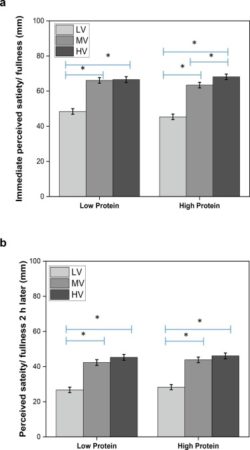
Also, sensory attributes such as visually perceived smoothness, thickness, creaminess and watery were shown to be important factors in the perception of satiety (the creamier or thicker the beverage the higher the perceived satiety scores). To summarise, a video-based online demonstration is a highly feasible and convenient tool to measure the effect of food texture on perceived/expected satiety that can be useful in Covid-19 pandemic situation, latter necessitates online participation in many situations. More importantly, key role of food/beverage texture expressed through visual cues alone, may open new avenues of informing consumers about the degree of the perceived satiety/fullness even before the product is consumed.
New paper titled “Effects of oral lubrication on satiety, satiation and salivary biomarkers in model foods: A pilot study" published in Appetite
With a dramatic increase in overweight and population with obesity over the last decades, there is an imminent need to tackle this issue using novel strategies. Addressing obesity issues by generating satiety in food to reduce energy intake has been one of those promising strategies and often textural interventions have been used to generate satiety, specifically in short-term trials. In recent years, there has been increased interests from researchers in understanding the role of structural/ textural complexity of food, specifically through the development of model foods such as hydrogels in generating satiety. Among the textural complexity, effect of oral lubrication on satiety has thus far attracted very limited attention in literature. An innovative way to explain the link between food texture and satiety and satiation is to consider salivary biomarkers, which are important contributors to oral lubrication. In this study published in Appetite, Volume 165 (Article No. 105427) https://doi.org/10.1016/j.appet.2021.105427 , the aim was to examine the effects of hydrogels as model foods varying in their oral lubrication properties on satiety, subsequent food intake as well as concentration of salivary biomarkers and frictional properties of the collected saliva from volunteers. The study (registered at ClinicalTrials.gov as NCT04240795) was an acute, single-blinded, randomized, counterbalanced, within-subject designed cross-over trial. Figure below shows the protocol of the study (a) and images of the hydrogels (b) and (c).

In short, participants had to come to the laboratory on three visits where they were asked to eat one of the hydrogels or control (water), provide appetite ratings at certain time points and saliva was collected on three occasions at each visit. Also, participants had ad libitum lunch on each visit, 30 min after eating the preload (hydrogels differing in their lubricating properties or control – water). In the figure below it can be seen that hunger (a) decreased immediately after preload and remained decreased for 10 and 20 min, respectively, after preload in the high lubricating condition compared to control (all p < 0.05). Fullness (b) increased immediately after preload and remained increased for 10 and 20 min, respectively, after preload in high lubricating condition compared to control (p < 0.05).

However, after controlling the values for baseline, such significant effect of the intervention did not exist anymore. Only the effect of time was observed. Therefore, the results should be interpreted with caution. Oral lubrication showed a brief effect on appetite sensations (data not controlled for baseline) but no effect on food intake and salivary biomarkers. Interestingly, salivary lubrication correlated with feeling of fullness as shown in figure below.

In summary, when data are not controlled for baseline, model food (hydrogels) with higher lubricating properties showed to suppress appetite ratings compared to water, and such effect is brief. However, after controlling the data for baseline, the effect of intervention does not exist anymore. No effect of lubricity on food intake and salivary biomarkers was found, which might be associated with the subtle change in lubrication between the preloads or the long time between the intervention and the measurement. Therefore, future research should reduce the time between preload and next ad libitum meal in order to demonstrate the immediate effect of lubricity on satiety and satiation. In addition, studies should also employ energy density and macronutrients/real food as opposed to non-calorific hydrogels to understand the combinatorial effect of calorie and lubricity to be closer to real food and test the effects on satiety.
New review paper titled “Oral tribology: providing insight into oral processing of food colloids “ published in Food Hydrocolloids
Research on food oral processing has attracted a great deal of attention in the last few decades owing to its paramount importance in governing sensory appreciation and involvement of the latter in regulating nutrient intake. Tribology, the science of friction, lubrication and wear has emerged as a powerful tool to deconvolute the complex phenomena occurring in oral processes and provide insights into the physics of it. Therefore, an overarching review (Food Hydrocolloids, Volume 117, Article No. 106635) paper providing an overview of tribological experiments relevant to food colloids is a great addition to the literature and can trigger diverse follow-on research in oral tribology. A time-resolved Figure as shown below is presented in the paper on the systematic progress in oral tribology of food colloids and colloidal ingredients over the last 10 years focusing on food polysaccharides, proteins, gels, microgels and fluid gels, emulsion microgels to foods such as yoghurts, cheese etc as shown in the figure below.
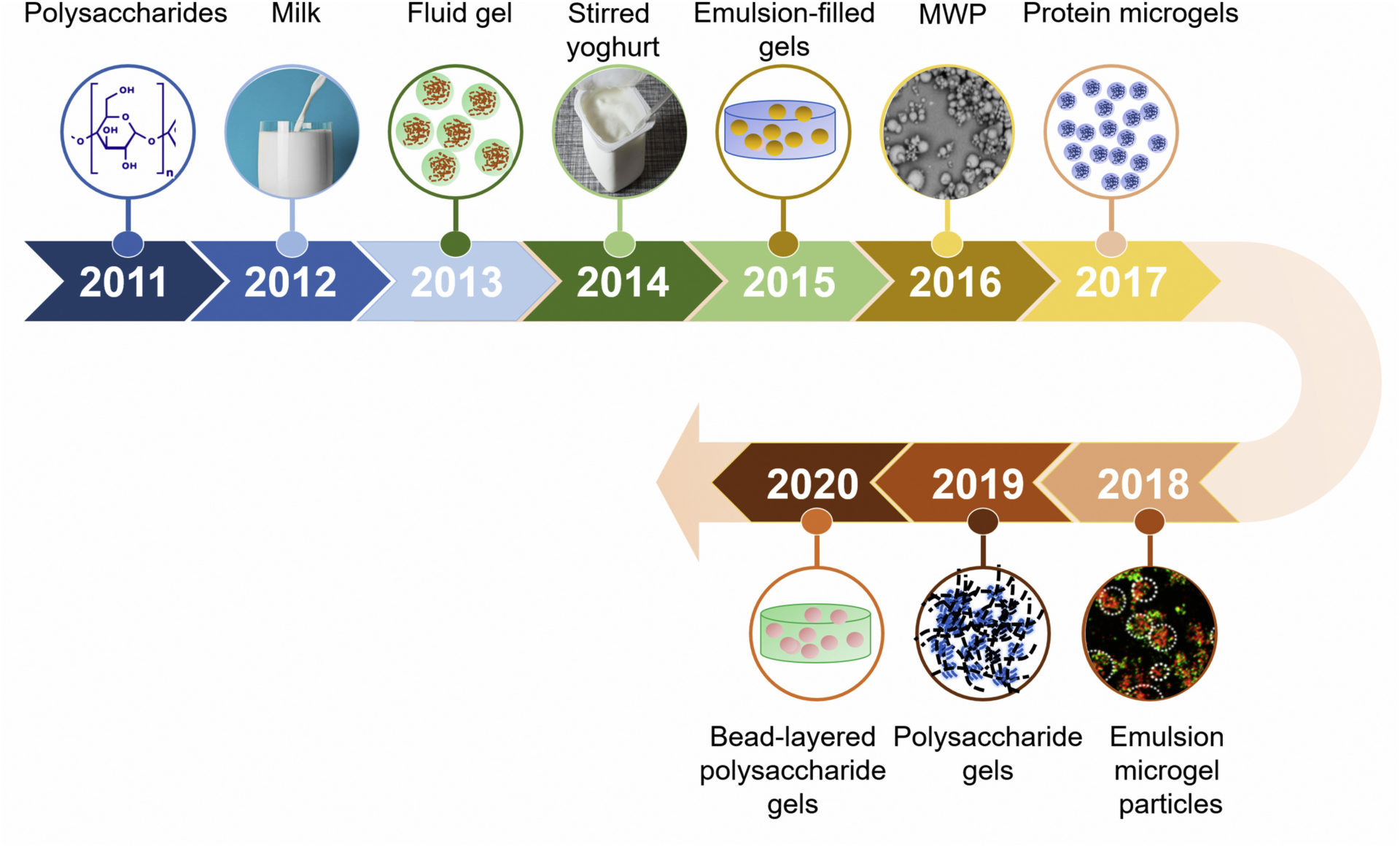
The paper enlightens the reader as to the pathway in which the field is evolving to address various food science challenges.
This review paper covers works carried out in the area of food colloids where tribological experiments have been exploited and provides a detailed and practical overview of lubrication theories trimmed towards oral processes. In this paper, we explain lubrication regimes occurring in tribological contacts - those are being boundary, mixed, elasto-hydrodynamic (EHL) and hydrodynamic (HD)- and their contributions to frictional forces under tribo-shear stresses. The influence of surface roughness of materials on the lubrication regimes are elucidated in the paper.

The Figure, here, shows a typical curve, i.e. the Stribeck curve, in tribology which unveils the speed-dependent lubrication behaviour of fluids including food substances resulting in the different lubrication regimes highlighted above. The figure highlights the importance of adsorption (e.g. saliva) and viscous behaviour (syrup) of food systems and elastic response of oral surfaces (i.e. tongue deformation). The influence of viscoelasticity of soft material (VESM) on the friction coefficient of the EHL regime is shown in dashed blue line. The viscoelasticity of the material leads to asymmetric pressure distribution and distortion of the elasto-hydrodynamic lubricant film. This eventually voids the linear correlation between the friction coefficient and entrainment speed in log-log scale, usually observed for mainly elastic/plastic materials. Also, viscosity-dependent factors can be seen in the mixed/boundary regimes. This results from decaying influence of viscosity on de-wetting and squeeze-out dynamics of the lubricant molecules at the contact interface and viscoelastic deformation of roughness on soft surfaces. This brings about a lower friction coefficient through lubricant retention at the contact interface through a viscous boundary layer (VBL) of a viscous lubricant which is shown in dash-dotted green line. A more pronounced influence of moieties in food or oral cavity on the Stribeck curve can be observed upon surface adsorption/bonding. Adsorbed lubricious thin layers (ALTL) can considerably reduce friction in the mixed and boundary regime and this influence is demonstrated using a dotted red line. The friction of food systems can be linked to their mouthfeel and hence a healthy food can be designed replicating the taste of fat-based food systems with significantly low-calorie indexes.
An overarching review of empirical equations available to estimate the minimum lubricant film thickness is presented in this review paper. The equations enable the readers to find out the lubrication regime taking place in a tribo-contact based on the experimental parameters (i.e. rolling-sliding speed, normal load and temperature) and the properties of contact-bodies (i.e. viscosity of the lubricant, and elastic modulus and Poisson ratio of the materials). Equations take into account the geometry of contact bodies resulting in different contact configurations, that are point , elliptical and line contacts shown in the Figure below.

Moreover, this paper informs the readers on the potential developments of tribology-assisted techniques to design healthier and sustainable foods with no compromise of mouthfeel. Tribology is proposed to be a valuable tool to detect food counterfeiting and tailor foods for vulnerable individuals (e.g. aging populations). In addition, this paper presents a suite of advanced complementary techniques including imaging (AFM), analytical (SAXS, XPS, Raman and CD) and adsorption (QCM-D, SPR and ellipsometry) which have assisted in understanding of frictional dissipation in food systems. The perspectives provided in this review thus represent an exciting glimpse of what tribology and spectroscopic techniques can offer, which may become a routine and integral step in food colloidal design in the future. To access the full paper and read around the oral tribology, use the following link: https://doi.org/10.1016/j.foodhyd.2021.106635
New research article on “Oral tribology, adsorption and rheology of alternative plant proteins” published in Food Hydrocolloids
Combined with the unpredictability of climate change and rise in veganism, there is an overwhelming need for more efficient, sustainable and ethical food proteins. The food industry has historically replaced animal protein (i.e. whey protein) with alternatives such as soy protein and more recently hypoallergenic pea protein for use in a vast number of products from meat analogues to high protein milks. However, often alternative proteins are associated with unpleasant mouthfeel perception, such as roughness, dryness, astringency, which severely limit their consumer appeal and use in food design. Often such mouthfeel perception are physically driven and therefore characterizing rheological, tribological and adsorption properties of alternative proteins can provide deeper insights into their use in food product design and ability to replace animal proteins.
This study published in Food Hydrocolloids, Volume 116 (Article no. 106636), https://doi.org/10.1016/j.foodhyd.2021.106636 looks at soluble fractions of alternative proteins (pea protein (PPCsol), potato protein (PoPIsol), lupine protein (LPIsol) and insect protein (IPCsol) compared to whey protein (WPIsol) at concentrations of 1-10 wt% in terms of hydrodynamic diameter, lubrication, adsorption and rheology with a secondary aim of predicting lubrication behaviour based on other instrumental characterisation.
All proteins were negatively charged (~20 mv) as expected at neutral pH with hydrodynamic diameters ranging from 25 – 244 nm. At low protein concentrations (1 wt%) three of the five proteins (PoPIsol, PPCsol, IPCsol) significantly increased lubrication compared to the control buffer. At 5 wt%, all proteins effectively increased lubrication compared to the buffer as sufficient protein allowed fomation of a hydrated layer between the tribological contact surfaces. Interestingly at high protein concentrations (10 wt%), presence of alternative proteins, especially PoPIsol and IPCsol increased the friction between the contacts in contrast to WPIsol. Overall PPCsol had the poorest lubrication ability of all proteins and didn’t show much improvement on increasing the concentration from 1 to 10 wt%, whilst WPI continued to improve in lubrication on increasing the protein concentration. The figure below (1.0 wt% (a), 5.0 wt% (b), and 10 wt% (c) protein, respectively and scaling of friction curves (d) of 10 wt% proteins to high shear rate viscosity (η∞ = 1000 s−1)) demonstrates such tribological behaviour and such increase in friction in presence of alternative proteins at higher concentration is thought to be due to aggregation of alternative proteins jamming the contacts.
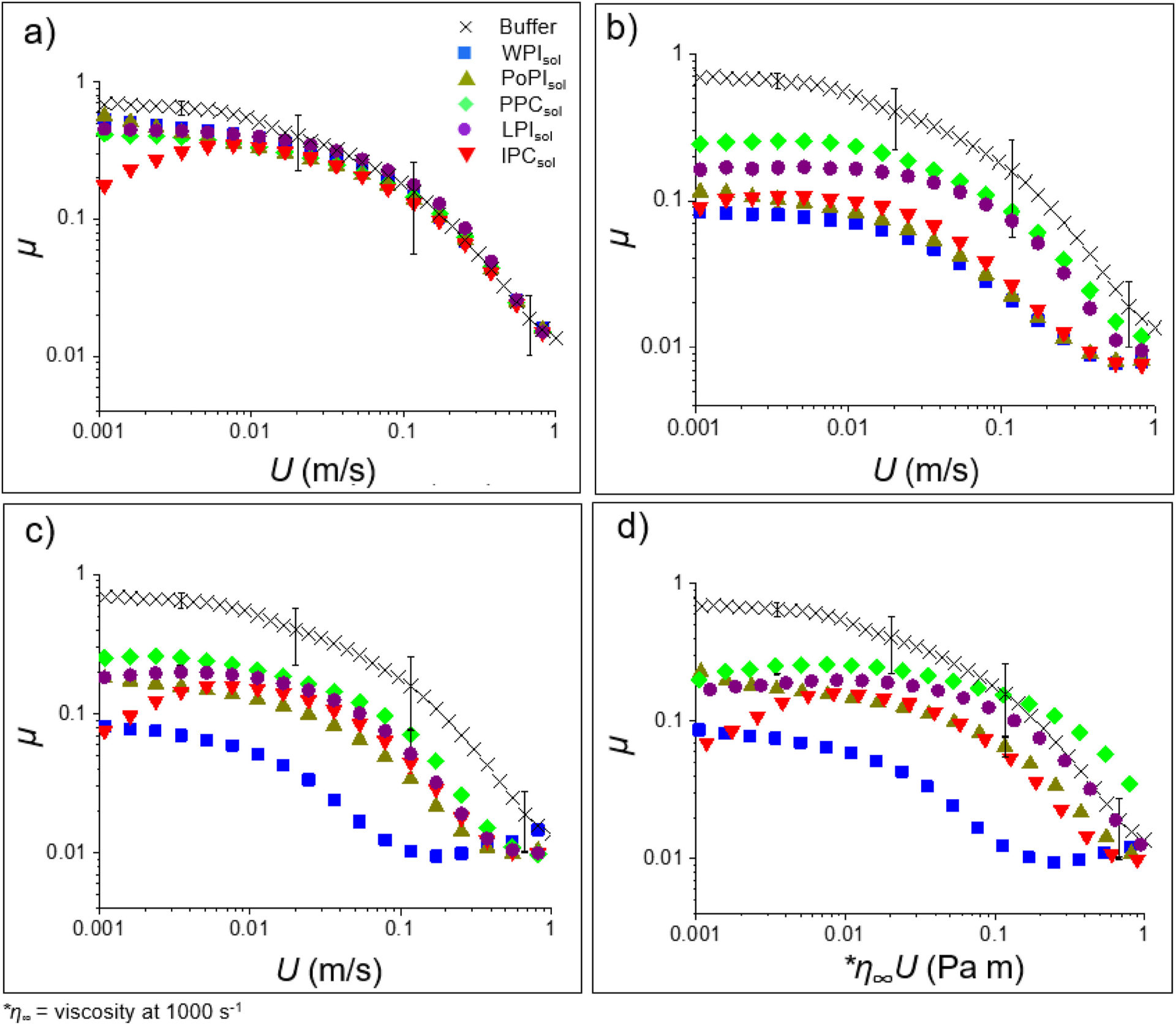
Quartz crystal microbalance with dissipation monitoring (QCM-D) was further implemented to characterise viscoelasticity and hydrated mass of each of the proteins. A pictorial schematic (figure) is displayed below and it was found more rigid proteins (WPIsol, PoPIsol) led to better lubrication performance when present between hydrophobic contact surfaces as compared to more viscoelastic proteins (PPCsol).

Utilising all the characterised data Pearson’s correlation was conducted and we identified a number of key lubrication improving traits for alternative proteins. This figure below shows traits such as smaller size, more rigid surface layer and lower hydrated mass contribute to improved lubrication.

Overall this study using novel proteins, some of which for the first time characterised in literature, sheds light as to why alternative proteins may encounter negative mouthfeel perceptions at higher concentration. Alternative proteins may still be utilised to lubricate at lower concentrations. Among the tested proteins, potato protein seems to stand out in its lubrication performance because of its smaller size and ability to form a rigid layer at the surface. Sensory tests are key to understand whether such increased lubrication, hydrated mass and viscoelasticity are actually associated with positive mouthfeel perception such as smoothness in alternative proteins.
New research article on "Friction between soft contacts at nanoscale on uncoated and protein-coated surfaces" published in Nanoscale
A plethora of soft sliding interfaces exist in the human body as well as in technological applications where low friction is often a requirement to ensure proper functioning. However, due to a variety of reasons, large frictional forces may develop that can have serious implications from irritation to severe pain in cases such as arthritis or xerostomia. With the development of techniques that measure friction at the nanoscale such as friction force microscopy (FFM), a technique based on atomic force microscopy (AFM), a more relevant insight can be achieved on biotribological mechanisms that otherwise is not possible with macroscale techniques. For instance, due to the very low sliding speeds and small contact areas at nanoscale, frictional contact is likely to be in the boundary regime and the effect of hydrodynamic film lubrication observed with other techniques can be ignored. While a great deal of work in literature has focussed on the nanotribological properties, the materials used in these studies were often hard or relatively hard when compared to actual biological surfaces, which tend to have Young's moduli ranging between a few tens of kPa to a few tens of MPa.
In this study published in Nanoscale, https://doi.org/10.1039/D0NR06527G, friction force microscopy was employed to examine how the nanotribological properties of a model biological surface coated with proteins are affected by deformability of the surface. More specifically, spherical polydimethyl siloxane (PDMS) colloid-probes were fabricated for FFM, and PDMS surfaces were tuned in modulus from MPa to the kPa range, successfully replicating the elastic modulus of biological surfaces. Results demonstrated that on hard-soft contacts i.e. borosilicate glass probe (BSG) on bare PDMS surfaces, friction is well described by single asperity models. In contrast, friction on protein-coated surfaces can be described by macroscopic models (Amonton's law) depending upon the protein type. As seen in the figure below (a and b), the contact area and deformation increase with load as L2/3 a consequence of the JKR model.
The contact area between the BSG probe and PDMS surface is smaller than that of the PDMS probe, as a result of the different elastic modulus; the hard BSG probe does not deform and, thus, results in decreased contact area. Furthermore, the BSG probe exhibits an increased maximum pressure at the centre of contact, almost threefold higher than that of the PDMS probe (see figure below (c and d)). Additionally, the pressure is distributed more evenly from the PDMS probe due to its deformability.  Negatively charged β-lactoglobulin (β-lg) and positively charged lactoferrin (LF), both of which are globular proteins that are components of whey protein were selected in order to coat the PDMS surfaces and screen the large adhesion between PDMS–PDMS surfaces. Protein coated surfaces revealed significant differences in their lubricating properties associated with the protein affinity towards the surface (see figure below with buffer (a and b), lactoferrin (LF) (c and d)and β-lactoglobulin (β-lg) (e and f)) and QCM-D results (g and h).
Negatively charged β-lactoglobulin (β-lg) and positively charged lactoferrin (LF), both of which are globular proteins that are components of whey protein were selected in order to coat the PDMS surfaces and screen the large adhesion between PDMS–PDMS surfaces. Protein coated surfaces revealed significant differences in their lubricating properties associated with the protein affinity towards the surface (see figure below with buffer (a and b), lactoferrin (LF) (c and d)and β-lactoglobulin (β-lg) (e and f)) and QCM-D results (g and h).
To our knowledge this is the first study at the nanoscale level with well-defined soft colloidal probes and surfaces of variable and controllable modulus, demonstrating the significant role played by Young's modulus of a protein-coated surface in affecting its frictional properties. The work highlights the importance of selecting model systems that closely match the mechanical properties and chemical properties of the biological systems of interest, and applying the correct contact mechanics (in this case JKR) if truly meaningful results are to be generated from such model studies. It also reveals the complex interplay of multiple factors governing friction between soft interfaces: adhesion governing the contact area in soft contact; the modulus of each surface governing deformation and again the contact area and pressure; the load applied; the nanoscale morphology of the surface, or of any adsorbed film which controls the contact mechanics and determines single or multi-asperity contact; the chemical affinity of the adsorbed proteins for the surface, which controls the morphology and robustness of the film, and the chemical nature of the two surface in terms of hydrophillicy/hydrophobicity.
New research article on "Rheology and tribology of starch + κ‐carrageenan mixtures" published in Journal of Texture Studies
There has also been a gradual increase in interest in understanding specifically the tribological properties of polysaccharides, since they can play an essential role in adjusting the mouthfeel of foods and beverages. Starch is the most commonly used polysaccharide in foods that affects food structure and texture and starch textural properties tend to vary widely depending on their origin, for example, corn (maize), wheat, potato, tapioca, and rice. In addition, the textural properties of starches of one origin depend on the starch granule size, shape, degree of swelling, disruption, that is, gelatinization. The lubricating behavior of non‐starch polysaccharides, such as locust bean gum, carrageenan, gellan, guar, pectin, xanthan gums, and so forth in the boundary and mixed lubrication regimes has also attracted recent research attention. Although some information on the tribological properties of biopolymer solutions is available in the literature, studies of combinations of biopolymers are very rare. This study published in Journal of Texture Studies https://doi.org/10.1111/jtxs.12570 investigated the rheological and tribological properties of biopolymer mixtures of gelatinized corn starches (0.5 – 10.0 wt%) and κ‐carrageenan (κC) (0.05 – 1.0 wt%). Two different starch samples were used. The first starch (CS1), despite extensive heating and shearing contained “ghost” granules as shown in the figure below in both optical micrograph (a) and confocal micrograph (b),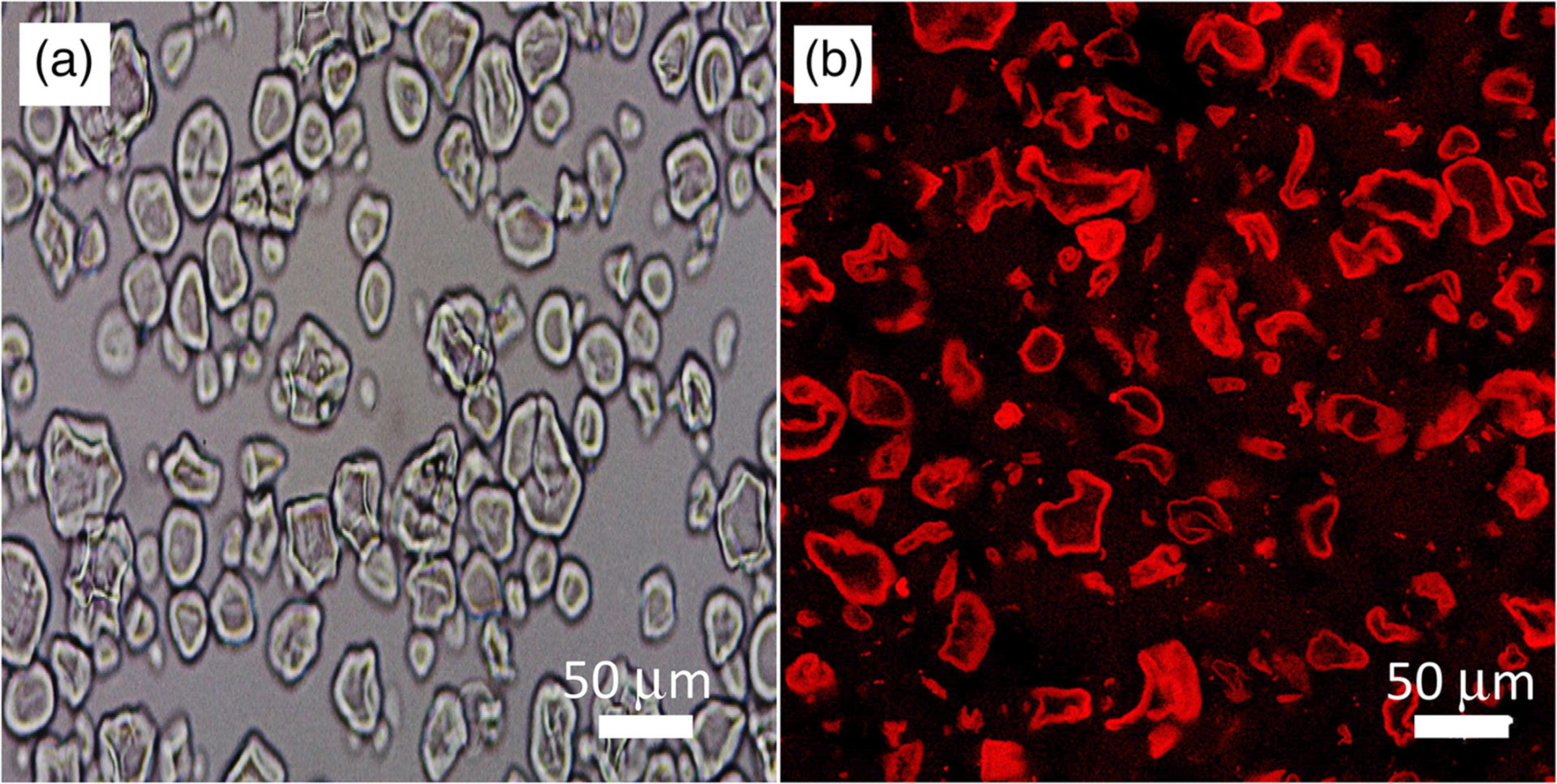 while the second starch (CS2) had no visible ghost granules after the same gelatinization process as CS1. Apparent viscosity measurements demonstrated that κC + CS1 mixtures were shear thinning liquids, with viscosity values being lower than the corresponding weight average of the values of the individual equilibrium phases at shear rates < 50 s−1. Tribological results revealed that κC ≥ 0.5 wt% was required to observe any decrease in friction coefficients in the mixed lubrication regime as shown in the figure below.
while the second starch (CS2) had no visible ghost granules after the same gelatinization process as CS1. Apparent viscosity measurements demonstrated that κC + CS1 mixtures were shear thinning liquids, with viscosity values being lower than the corresponding weight average of the values of the individual equilibrium phases at shear rates < 50 s−1. Tribological results revealed that κC ≥ 0.5 wt% was required to observe any decrease in friction coefficients in the mixed lubrication regime as shown in the figure below.
Starch (CS1) showed an unusual behavior at ≥ 5 wt%, where the friction coefficient decreased not only in the mixed regime but also in the boundary regime, probably due to the presence of the “ghost” granules, as the latter became entrained in the contact region. The CS1 + κC mixtures showed significantly lower friction coefficients than that of pure CS1 and κC in the mixed regime.

However, the CS2 + κC mixture (i.e., containing no ghost granules) showed similar behavior to pure κC in the mixed regime, while lower friction coefficients than that of the pure CS2 and κC in the boundary regime as shown in the figure below. These findings illustrate new opportunities for designing biopolymer mixtures with tunable lubrication performance, via optimizing the concentrations of the individual biopolymers and the gelatinization state of the starch. Ongoing studies are focusing on identifying the exact mechanisms of the tribological behavior, to allow their fine‐tuning for fat mimetic applications.
New review paper on "Review on fat replacement using protein-based microparticulated powders or microgels: A textural perspective" published in Trends in Food Science and Technology
Obesity is a growing health concern and socio-economic crisis globally. As a consequence, policy-makers and consumers are addressing dietary and associated health issues and, consequently food industries are attempting to accelerate their innovations in creating lower calorie food products. Reducing fat in foods is one of the potential strategies to decrease calorie intake significantly and consequently, low fat versions of foods are gradually populating the supermarket shelves. However, many if not most, of these products are inferior in taste, texture and appearance as compared to their FF counterparts and thus do not thrive in the marketplace. Hence, there has been motivation in the food industry and research community to design fat replacers that mimic the functional and sensory properties of fat. Proteins are often considered as a suitable macronutrient to replace fat as they contribute to only 4 kcal per gram with more satiation, per calorie, compared to other macronutrients. In addition, protein is also a highly tuneable structuring agent by virtue of its responsiveness to pH, ions, temperature and enzymes.
In the first figure, the reported bibliographic data for fat replacers and protein-based fat replacers can be seen, showing the growth of scientific literature and citations with the highest number of publications being produced since 2017, highlighting the topical nature and importance of this field in the period (1998–2018). This review published in Trends in Food Science and Technology, Volume, Pages 457-468 aims to assess the progress in the last 5 years in the design and application of protein-based fat replacement strategies in model and real food systems. We briefly discuss the protein concentrates of animal and plant origin followed by a strong emphasis on microparticulated forms of proteins that have been used as fat replacers. As a fat replacer, whey protein appears to dominate the field with most usage in dairy fat replacement. There has been recent interests in the use of plant proteins, however characterisation, understanding and application is highly limited to date. Besides particle size, rheology and sensory evaluation, tribology appears to be a new tool that is being applied to understand the lubrication properties of fat replacers mostly in model food systems. Combination of tribology with muco-adhesion techniques can be powerful screening tools for identifying fat replacers with just-right mouth feel properties in the future for sensory testing.
the reported bibliographic data for fat replacers and protein-based fat replacers can be seen, showing the growth of scientific literature and citations with the highest number of publications being produced since 2017, highlighting the topical nature and importance of this field in the period (1998–2018). This review published in Trends in Food Science and Technology, Volume, Pages 457-468 aims to assess the progress in the last 5 years in the design and application of protein-based fat replacement strategies in model and real food systems. We briefly discuss the protein concentrates of animal and plant origin followed by a strong emphasis on microparticulated forms of proteins that have been used as fat replacers. As a fat replacer, whey protein appears to dominate the field with most usage in dairy fat replacement. There has been recent interests in the use of plant proteins, however characterisation, understanding and application is highly limited to date. Besides particle size, rheology and sensory evaluation, tribology appears to be a new tool that is being applied to understand the lubrication properties of fat replacers mostly in model food systems. Combination of tribology with muco-adhesion techniques can be powerful screening tools for identifying fat replacers with just-right mouth feel properties in the future for sensory testing.

Besides proteins and commercially available microparticulated proteins, microgels as shown in the atomic force microscopic figure (top one: whey protein microgel obtained by top down approach and bottom one: whey protein microgel obtained using bottom up approach) that are designed in laboratory-setting have recently demonstrated superior rheological and lubrication performance with ability to act as potential fat replacers. However, information lacking in sensory perception of microgels in literature and the challenges of tailored commercial scale microgel production appear to be the bottlenecks to find its usage in real food applications. To read the open access paper and read about protein-based fat replacers including isolates/ concentrates, microparticulated forms and microgels, click here: https://doi.org/10.1016/j.tifs.2020.10.032
New book chapter on "Oral Tribology of Polysaccharides" published in Handbook of Hydrocolloids (3rd edition)
Oral tribology deals with the study of friction, wear, and lubrication between oral surfaces that are in relative motion, such as tongue-oral palate, food-tongue, teeth-food, teeth-teeth, etc. Although food material scientists have extensively studied bulk rheology of food, tribology has attracted research attention relatively recently in order to understand the surface interactions between the food, saliva, or food-saliva mixtures and oral surfaces during oral processing. In this chapter titled "Oral Tribology of Polysaccharides" in Handbook of Hydrocolloids (3rd Edition), we focus on oral tribology of hydrocolloids, i.e., aqueous dispersions of starch and non-starch polysaccharides that are often used as fat replacers or bulking agents in food industries. We first examine the commercially available and custom-made tribometers that are used to measure the friction force in various food research laboratories as shown in the figure below.
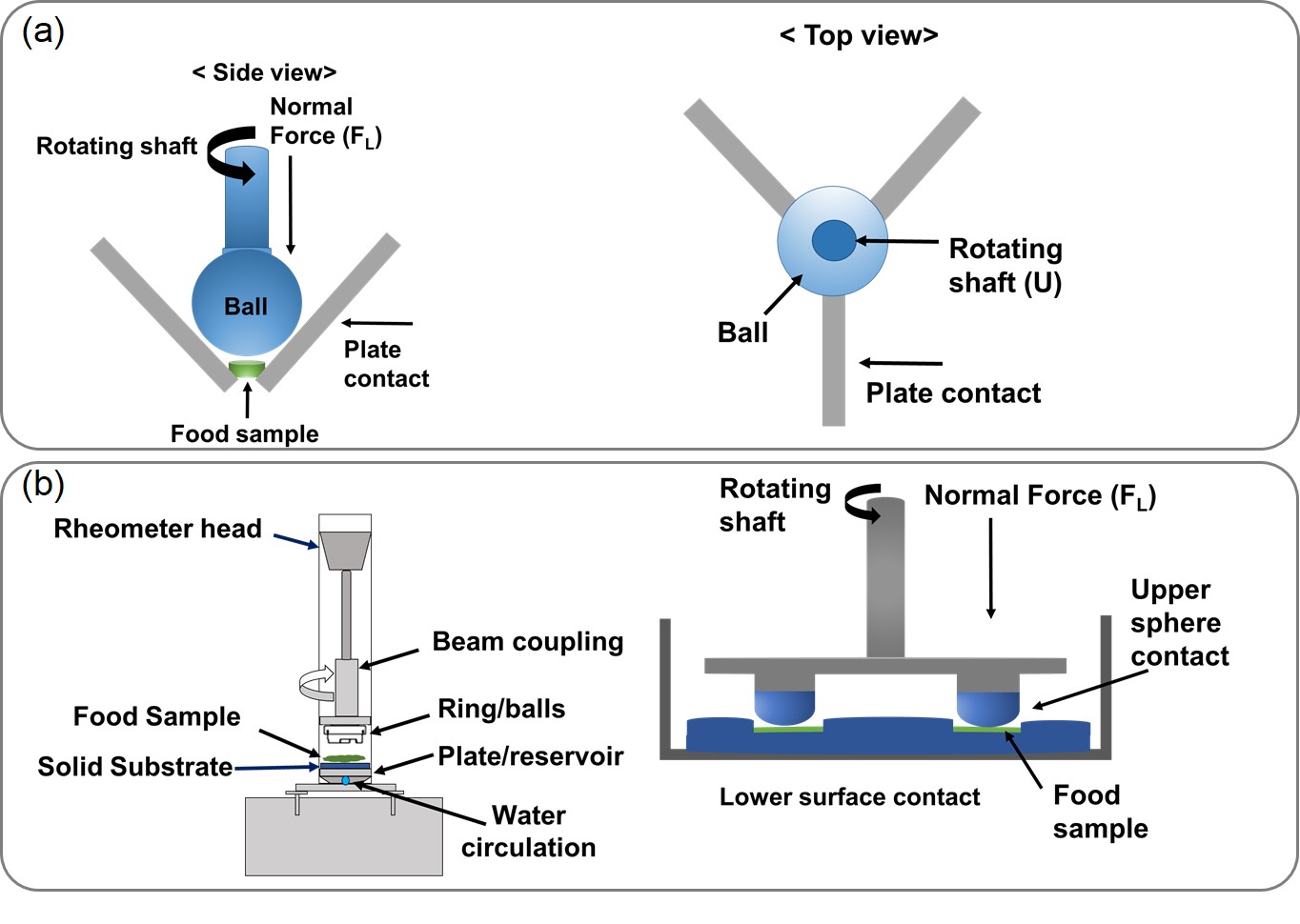
Considering the current need of the obesogenic society for fat replacers and low calorie bulking agents, understanding the oral lubrication mechanism of starch and non-starch polysaccharides as thickeners and/or as hydrogel particles have become more important than ever before. With the limited work carried out so far on tribology of food polysaccharides either in aqueous solution or as fluid gels, microgels or mixed gel fragments, few conclusive remarks can be drawn. Tribology of polysaccharides are mainly dictated by their molecular conformation (e.g. extended linear chain, random coil, rigid rod), size (nanometres (nms) to hundreds of microns), shape (e.g. irregular, spherical, ellipsoidal) and the degree of surface adsorption. One might then speculate that for a polysaccharide to be an ideal lubricant, it should have an extended chain like to allow it to enter into the contact and should have sufficient proteinaceous impurities that are capable of allowing interfacial adsorption. Although increasing polymer concentration has a prominent effect on increasing viscosity and subsequently reduce friction coefficients in the hydrodynamic regime, such viscosity effects might not always be realized in lower speeds i.e. boundary and mixed regimes, both these regimes are crucial from oral processing perspectives. For polysaccharide-based fluid gels or microgels, the gel particles should be sufficiently small to enter into the contact zone, have enough viscosity in the continuum to drag the gel particle into the contact zone as well as the elasticity of the particles should be high enough to avoid complete deformation by the pressures within the tribological shear region. Click here to read the full text to understand the lubrication mechanisms of food polysaccharides: https://doi.org/10.1016/B978-0-12-820104-6.00008-5
New Results on '3D biomimetic tongue-emulating surfaces for tribological applications' published in ACS Applied Materials and Interfaces
In humans, the tongue is integral to elemental activities of food transport, sensory perception of taste and texture, as well as speech. In mechanical terms, the human tongue is a soft tissue containing large asperities better known as papillae. Papillae located in the dorsal anterior section of the tongue, such as fungiform (dome-shaped shown in the top Figure) and filiform papillae (shown in the bottom Figure) are the key players in oral tribology.
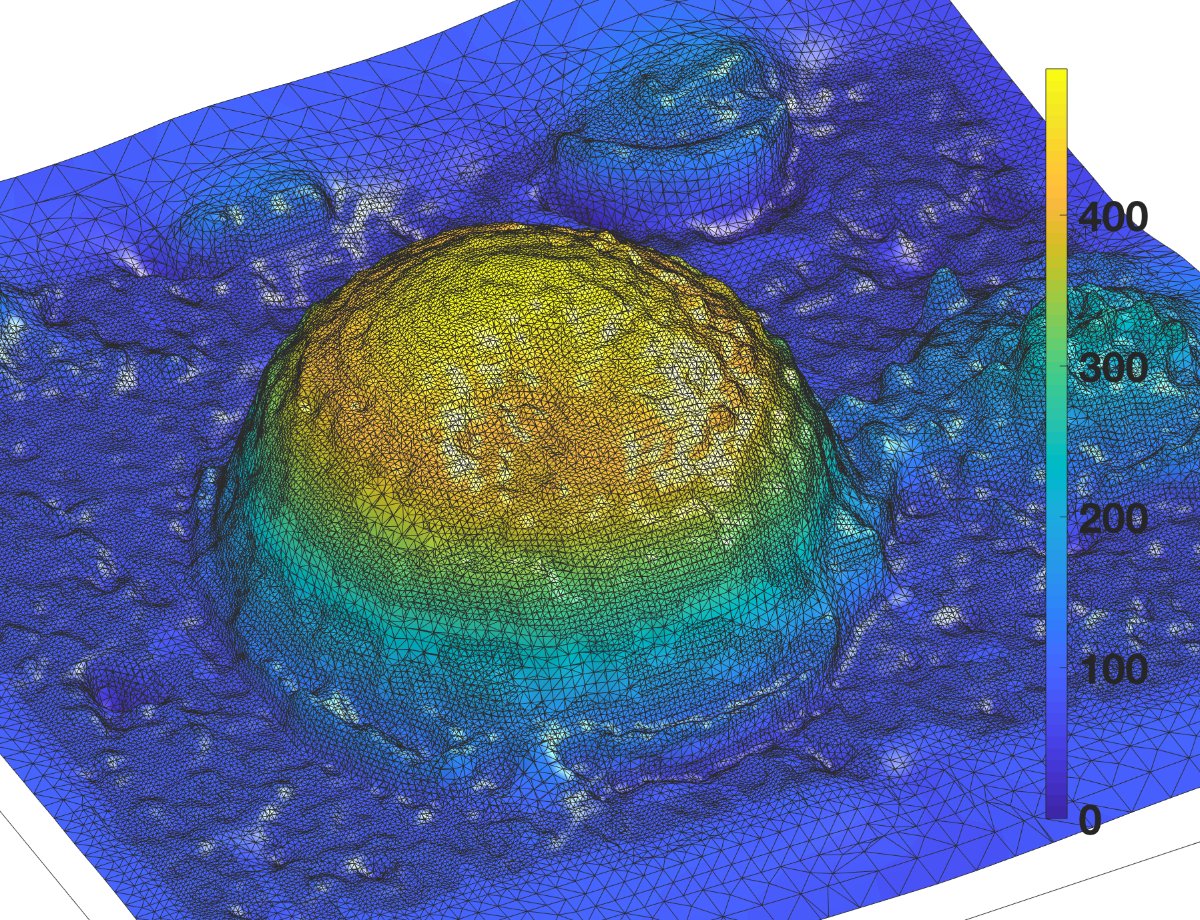
Put simply, they govern the friction and lubrication at the interface between food/oral fluids and the tongue. Although advances have been made in recent years in adapting tribological setups to measure friction, true emulation of the complex anatomical features of a real tongue surface and its physical performance remains incomplete.
Smooth elastomeric surfaces are generally used as the current state-of-the-art for in vitro oral tribology testing. However, they do not represent the highly textured tongue surfaces in vivo. Thus, creating a surface with relevant properties that mimics the intricate architectural features a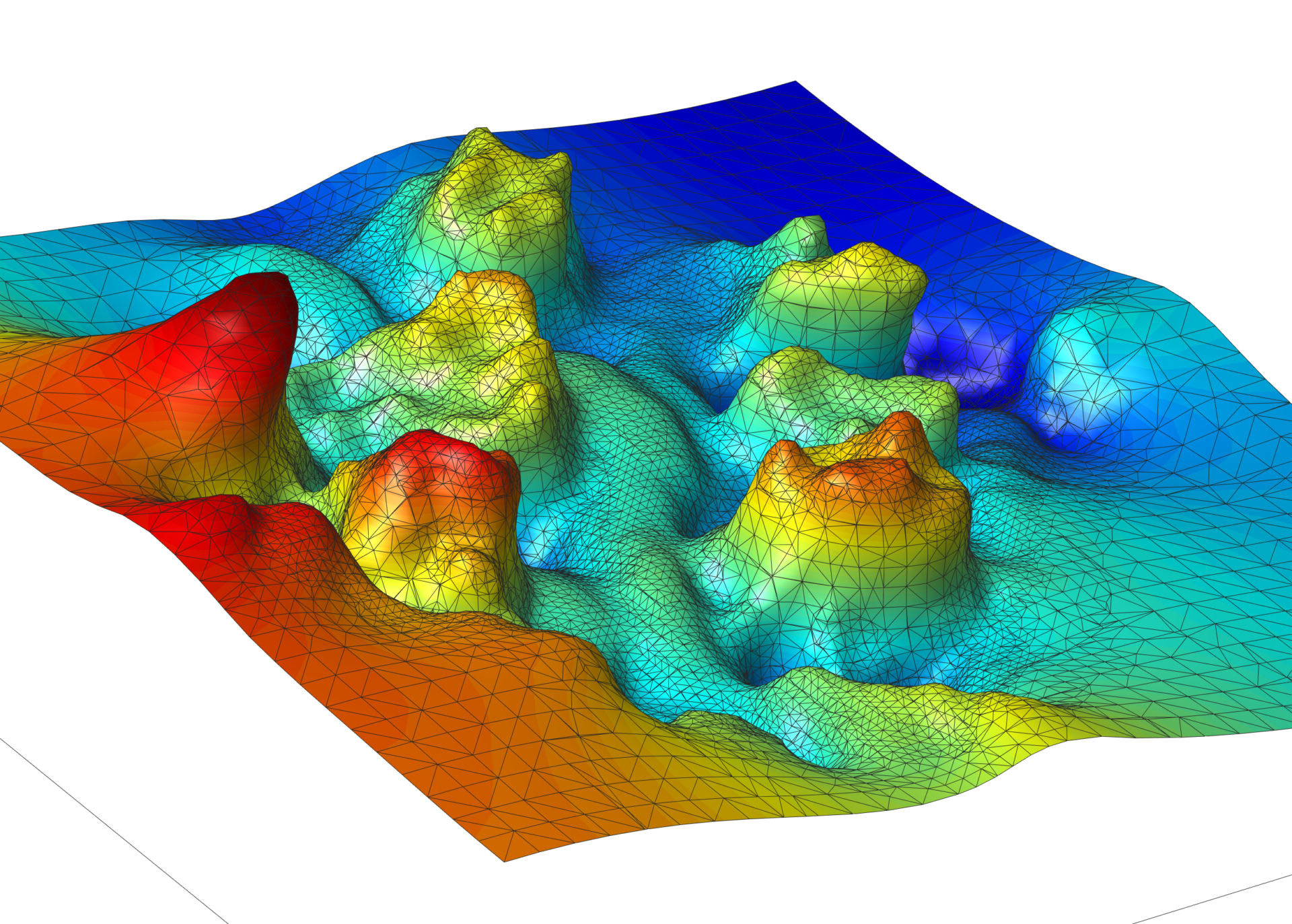 nd, more importantly, the mechanosensing and tribological performance of the human tongue is paramount to gain a quantitative understanding of how fluids interact within the oral cavity.
nd, more importantly, the mechanosensing and tribological performance of the human tongue is paramount to gain a quantitative understanding of how fluids interact within the oral cavity.
In this work published in ACS Applied Materials and Interfaces, Volume 12, Issue 44, Pages 49371–49385, we present a uniquely fabricated silicone surface that emulates the topology, elasticity and wettability of the human tongue to replicate its oral performance. In order to obtain accurate metrics of the texture of the human tongue, silicone masks of the tongue surfaces in hydrophobic and hydrophilic materials were obtained from 15 healthy human adults. Relevant architectural features of these tongue masks were measured after high quality 3D optical imaging, surface recreation using Screened Poisson reconstruction including identification of the papillae dimensions, density, distribution, as well as the average roughness of the surfaces. Using these metrics, an innovative biomimetic tongue surface was designed using a Poisson point process-based randomized model to create a master mold with the appropriate spatial distribution of fungiform and filiform papillae. In this study, the mold of the tongue mimicking surface was 3D-printed using advanced digital light processing technology in order to obtain the desired resolution (below 100.0 μm). Unique 3D biomimetic soft tongue-like surfaces were then obtained by soft lithography of the 3D-printed artificial surface using soft silicon elastomers with appropriate wettability modification as shown in the Figure below. Besides material properties, we were able to replicate the mechanical performance of a real human tongue for the first time.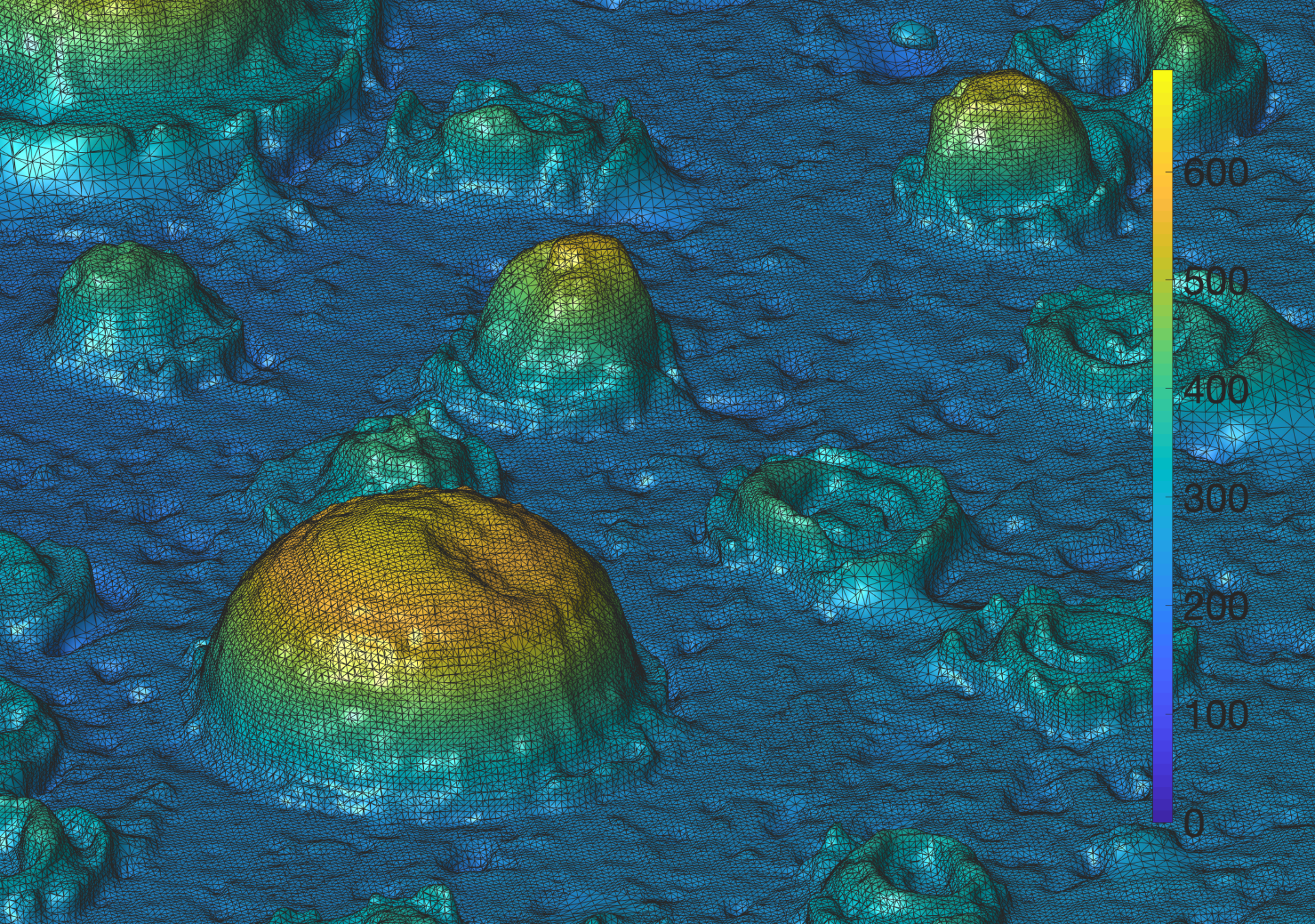 A key fundamental question we answered using computational simulation is that how grids, commonly used in literature to create biological replicas, lack the randomness of real human tongue and consequently fail to replicate the probability of food particle hitting a papillae. We defined collision probability per unit distance against a papillae as a novel measure for theoretically quantifying mechanosensing efficiency. We showed that this measure differs significantly between grid and random arrangements of papillae. Using computational simulation, we demonstrated for the first time that the randomized arrangement of papillae of precise geometries created in this artificial surface using Poisson point processes closely replicates the predictive mechanosensing of a real human tongue. Tribological experiments using different biopolymers acting as lubricants demonstrated the unprecedented capability of the artificial surfaces formed from the 3D-printed molds to replicate the tribological performance of the polymer surfaces molded on real human tongue masks.
A key fundamental question we answered using computational simulation is that how grids, commonly used in literature to create biological replicas, lack the randomness of real human tongue and consequently fail to replicate the probability of food particle hitting a papillae. We defined collision probability per unit distance against a papillae as a novel measure for theoretically quantifying mechanosensing efficiency. We showed that this measure differs significantly between grid and random arrangements of papillae. Using computational simulation, we demonstrated for the first time that the randomized arrangement of papillae of precise geometries created in this artificial surface using Poisson point processes closely replicates the predictive mechanosensing of a real human tongue. Tribological experiments using different biopolymers acting as lubricants demonstrated the unprecedented capability of the artificial surfaces formed from the 3D-printed molds to replicate the tribological performance of the polymer surfaces molded on real human tongue masks.
Hence, the 3D human tongue-like surface, i.e., the soft hydrophilic silicone surface textured with randomly distributed papillae-like (both fungiform and filiform) asperities fabricated in this study, represents a new biomimetic approach to quantify oral tribological performance of food and other oral fluids with accuracy. In addition, this offers a unique route forward for predicting mechanosensing and brings a step-change in our quantitative understanding of oral lubrication. This reduces the necessity for time-consuming and costly human trials consequently reducing the development cycle of oral products. At the same time, experimental and computational insights in this study can be extended to biomimicry of other biological surfaces in the future to match the desired biophysical performance requirement. To read the full paper, please click here: https://doi.org/10.1021/acsami.0c12925
New Results on 'Surface adsorption and lubrication properties of plant and dairy proteins: A comparative study' published in Food Hydrocolloids
With the rise in veganism and increased sustainability concerns, there has been increased interest towards use of alternative sources of proteins to replace animal proteins. Consequently, plant proteins (e.g., pea, soy) as alternatives to conventional animal proteins (e.g. casein, whey protein, gelatine) have gained significant research attention in recent years owing to the lower environmental footprints as compared to those associated with the production and consumption of the animal proteins. However, often plant proteins are associated with unpleasant textural attributes such as grittiness, astringency, which leads to rejection by consumers. A fundamental question arises on whether friction coefficient and surface adsorption can be used as feasible in vitro approaches to decipher the fundamental mechanism by which proteins interact with oral surfaces. In this direction, research on using quartz crystal microbalance with dissipation monitoring (QCM-D) as a complementary tool to tribological and rheological analyses on plant proteins and comparison with animal proteins will advance our fundamental understanding behind the physical mechanisms underpinning the textural differences between these proteins. Therefore, in this work published in Food Hydrocolloids (2021) Volume 111, Article 106364, the rheology, adsorption properties and the lubrication performance of the soluble fraction of pea and whey proteins, with or without heat treatment (HT), were compared using a combination of surface adsorption, tribology, rheology, surface wettability and other physicochemical characterization techniques. QCM-D results (see Table at the top) reveal that soluble fractions of pea protein isolate (PPI) adsorbed to significantly larger extent on PDMS surfaces, forming more viscous films as compared to whey protein isolate (WPI) regardless of heat treatment. Introducing a salivary mucin coating on the hydrophobic surface led to a decrease in binding of the subsequent dietary protein layers, with PPI still adsorbing to a larger extent than WPI (see Table at the bottom) . Such decreased binding was was due electrostatic repulsion between anionic mucin and negatively charged dietary proteins at oral pH. Such large hydrated mass of PPI resulted in superior lubrication performance at lower protein concentration (≤10 mg/mL) as compared to WPI. However, at 100 mg/mL, WPI was a better lubricant than PPI, with the former showing the onset of elastohydrodynamic lubrication as shown in the Figure below.
Introducing a salivary mucin coating on the hydrophobic surface led to a decrease in binding of the subsequent dietary protein layers, with PPI still adsorbing to a larger extent than WPI (see Table at the bottom) . Such decreased binding was was due electrostatic repulsion between anionic mucin and negatively charged dietary proteins at oral pH. Such large hydrated mass of PPI resulted in superior lubrication performance at lower protein concentration (≤10 mg/mL) as compared to WPI. However, at 100 mg/mL, WPI was a better lubricant than PPI, with the former showing the onset of elastohydrodynamic lubrication as shown in the Figure below.
 Enhanced lubricity upon heat treatment (HT) was attributed to the increase in apparent viscosity. Fundamental insights from this study reveal that pea protein at higher concentrations demonstrates inferior lubricity than whey protein and could result in unpleasant mouthfeel, and thus may inform future replacement strategies when designing sustainable food products. Click here to read the open access paper here: https://doi.org/10.1016/j.foodhyd.2020.106364
Enhanced lubricity upon heat treatment (HT) was attributed to the increase in apparent viscosity. Fundamental insights from this study reveal that pea protein at higher concentrations demonstrates inferior lubricity than whey protein and could result in unpleasant mouthfeel, and thus may inform future replacement strategies when designing sustainable food products. Click here to read the open access paper here: https://doi.org/10.1016/j.foodhyd.2020.106364
New Paper on 'Food texture influences on satiety: systematic review and meta-analysis' published in Scientific Reports
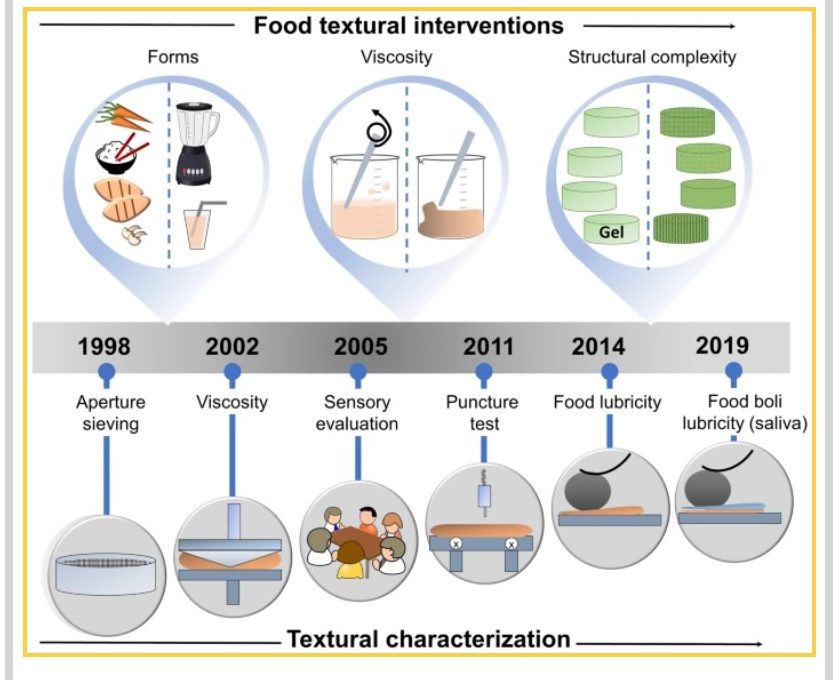
Obesity is one of the leading causes of preventable deaths. Development of satiety-enhancing foods is considered as a promising strategy to reduce food intake and promote weight management. Food texture may influence satiety through differences in appetite sensations, gastrointestinal peptide release and food intake, but the degree to which it does remains unclear. In this interdisciplinary work published in Scientific Reports, Volume 10, Article 12929 in collaboration with colleagues at Nutritional Sciences and Epidemiology Group as well as School of Psychology, we report the first systematic review and meta-analyses on effects of food texture (form, viscosity, structural complexity) on satiety. The objectives were to understand the influence of food texture on appetite control, including appetite ratings, such as hunger, fullness, desire to eat, thirst, prospective food consumption (how much food participants thought they could eat), food intake, and gut peptides, such as ghrelin, GLP-1, PYY and CCK. We hypothesize that higher textural characteristics (solid form, higher viscosity, higher lubricity, higher degree of heterogeneity, etc.) would lead to greater suppression of appetite and reduced food intake. As can be seen from the figure on the "history of food texture interventions in satiety trials", the field of ‘food texture-satiety’ was initiated by manipulation of physical forms of food i.e. solid versus liquid or versus semi-solid. Lately, a shift in focus occurred with more attention being given to the structural complexity of food, and to satiety studies using gel-based model foods with precise control over the texture; such gels avoid any emotional association with real food.
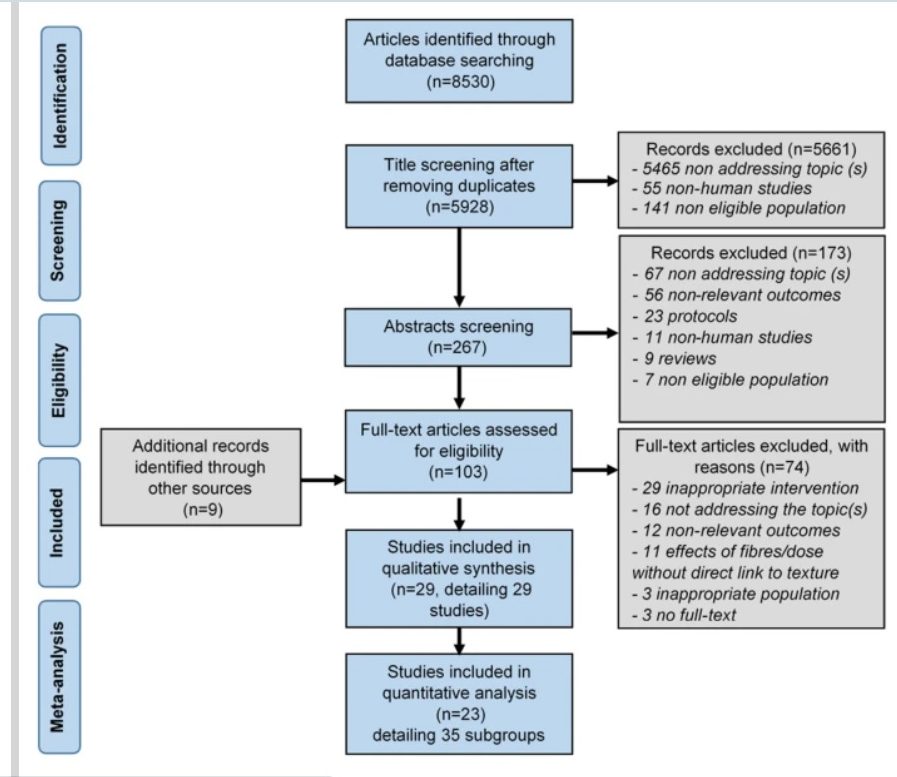
In this systematic review (see the PRISMA diagram), over 8500 articles were narrowed down to 23 specific papers based on stringent set of criteria. The meta-analyses revealed that both solid and higher viscous food reduce hunger by − 4.97 mm (95% confidence interval (CI) − 8.13, − 1.80) and − 2.10 mm (95% CI − 4.38, 1.18), respectively compared to liquid and low viscous food. An effect of viscosity on fullness (95% CI 5.20 (2.43, 7.97) and a moderate effect of the form of food (95% CI − 26.19 (− 61.72, − 9.35) on food intake were noted. Employing food textural manipulations such as increasing viscosity, lubricating properties and the degree of heterogeneity appear to be able to trigger effects on satiation and satiety. Unfortunately, many studies in this area were of poor-quality experimental design with no or limited control conditions, a lack of the concealment of the study purpose to participants and a failure to register the protocol before starting the study; thus, raising questions about the transparency and reporting of the study results. Future research should apply a framework to standardize procedures in order to have more consistent results and to justify a claim for an effect of food on subjective aspects of appetite and food intake. Finally, intervention studies with repeated exposure to novel foods with higher textural characteristics and less energy density are needed to clearly understand their physiological and psychological consequences, which will eventually help to create the next-generation of satiety- and satiation-enhancing foods. Click here to read the open access paper here: https://doi.org/10.1038/s41598-020-69504-y
New Results on 'Salivary lubrication (ex vivo) enhancement upon moderate exercise ' published in Archives of Oral Biology
Saliva is a nature-engineered lubricant found in the oral cavity and is fundamental to eating, swallowing, speech and one’s 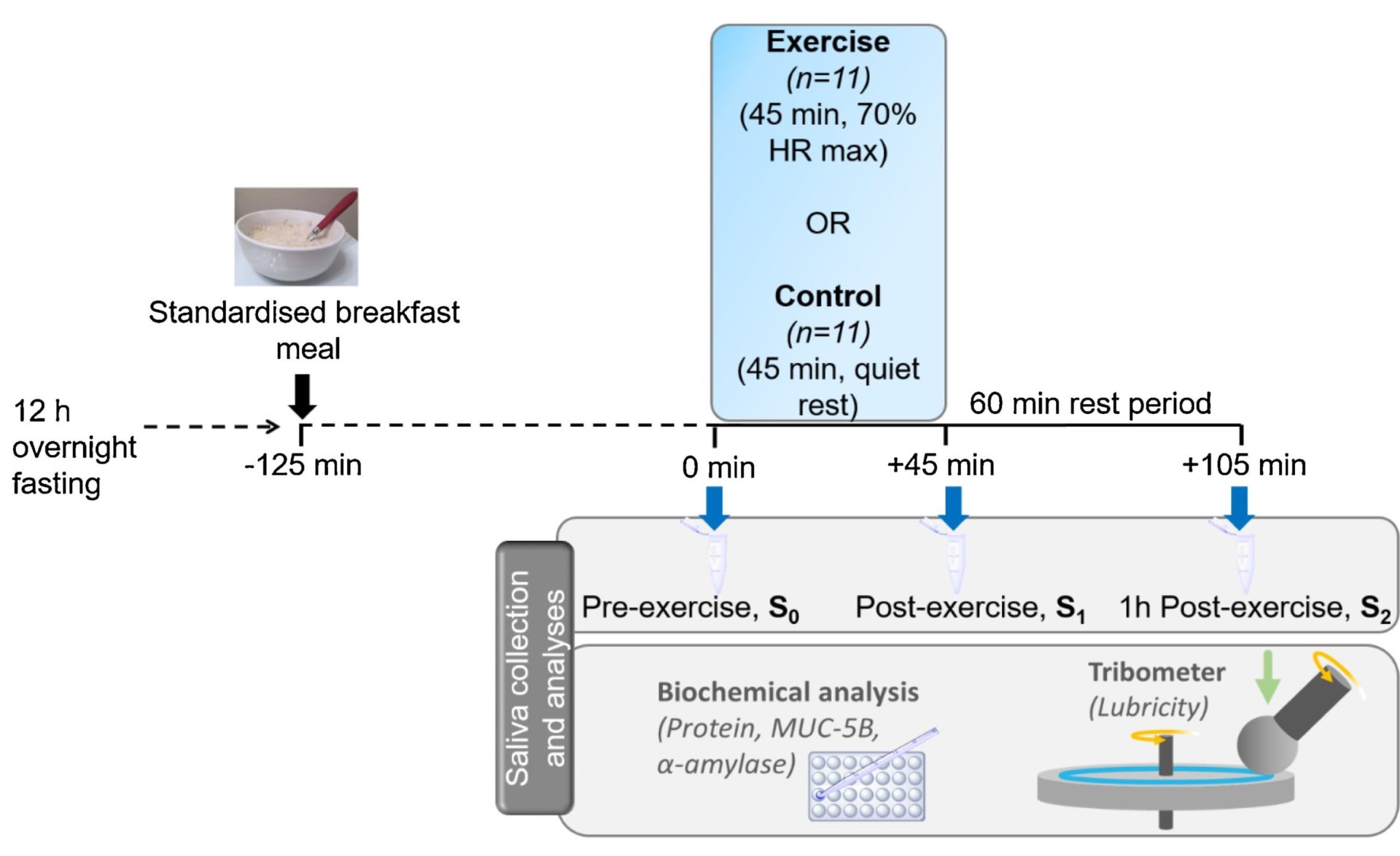 daily functioning. Recently, there has been an escalation in research interest on salivary lubrication largely fueled by the increased incidence of dry mouth or xerostomia resulting in poor quality and quantity of saliva. In this study pulished in Archives of Oral Biology, Volume 116, Article No. 104743, https://doi.org/10.1016/j.archoralbio.2020.104743, we examined changes in salivary lubricity after a bout of moderate intensity cycling for 45 min in healthy females as compared to a time-matched rest period. It was hypothesized that exercise would induce enhancement in salivary lubrication performance due to its effects on increases in protein and MUC5B content. Tribology results revealed that moderate intensity exercise resulted in enhanced lubricity of saliva with an order-of-magnitude lower friction coefficients in the boundary regime 45 minutes post exercise, with frictional forces being significantly lower as compared to the Control procedure. Total protein and α-amylase secretion also increased in the Exercise procedure. Inisghts from this proof-of-concept study reveals that moderate intensity exercise leads to an increase in α-amylase and total protein secretion resulting in enhanced lubrication performance of the saliva. However, the lubrication performance was not related to MUC5B content, suggesting the role of other proteinaceous species acting as lubricants. These preliminary results serve to design future exercise interventions in populations with dry mouth conditions.
daily functioning. Recently, there has been an escalation in research interest on salivary lubrication largely fueled by the increased incidence of dry mouth or xerostomia resulting in poor quality and quantity of saliva. In this study pulished in Archives of Oral Biology, Volume 116, Article No. 104743, https://doi.org/10.1016/j.archoralbio.2020.104743, we examined changes in salivary lubricity after a bout of moderate intensity cycling for 45 min in healthy females as compared to a time-matched rest period. It was hypothesized that exercise would induce enhancement in salivary lubrication performance due to its effects on increases in protein and MUC5B content. Tribology results revealed that moderate intensity exercise resulted in enhanced lubricity of saliva with an order-of-magnitude lower friction coefficients in the boundary regime 45 minutes post exercise, with frictional forces being significantly lower as compared to the Control procedure. Total protein and α-amylase secretion also increased in the Exercise procedure. Inisghts from this proof-of-concept study reveals that moderate intensity exercise leads to an increase in α-amylase and total protein secretion resulting in enhanced lubrication performance of the saliva. However, the lubrication performance was not related to MUC5B content, suggesting the role of other proteinaceous species acting as lubricants. These preliminary results serve to design future exercise interventions in populations with dry mouth conditions.
New Results on 'Tribology, Rheology and Sensory Perception of Bead-layered Hydrogels' published in Food Hydrocolloids
Foods in general are heterogeneous composite structures with particles of various sizes, shapes and viscoelastic moduli embedded in complex polysaccharide and protein networks. Examples of such composite foods may range from the conventional use of freeze-dried fruit pieces in porridge and yoghurt, and starch granules in custards to the more recent usage of flavoured gelatine pearls in confectionery, pieces of cookies in ice creams and seeds/nuts inclusion in cheese, etc. Indeed such interesting inclusions of particles are increasingly enabling novel texture creations and triggering hedonic escalation of these palatable foods. In addition to creating new hedonic textural experiences, there is an increasing body of evidence showing texturally complex foods containing inclusions can influence oral processing behaviour in human subjects. Nevertheless, it remains elusive in literature whether consumers can distinguish particle sizes for soft particles or not? It is also important to understand how the instrumental and sensorial response of hydrogels with polymeric soft gel particle inclusions might alter if the soft gel particles were present as “layers” rather than being incorporated homogeneously in the matrix.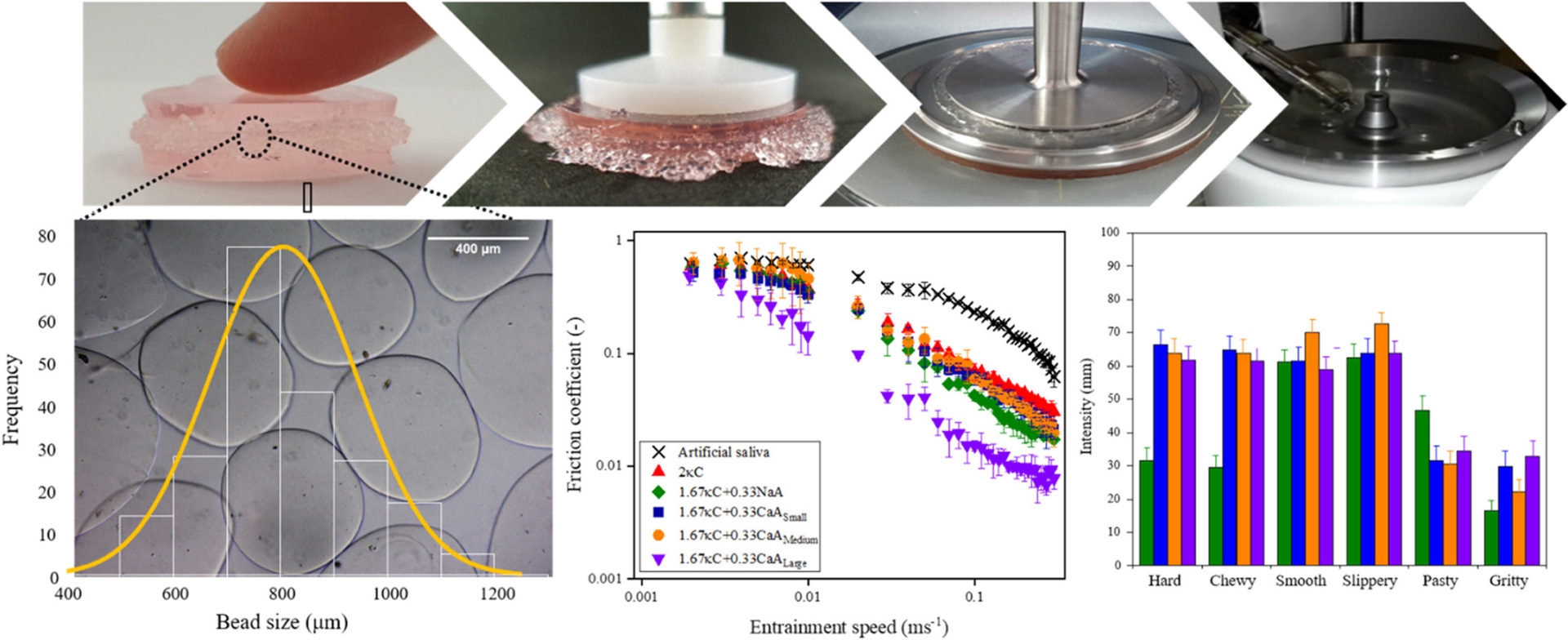
New work by Ecaterina Stribiţcaia (PhD Student, ERC LubSat Project) on Tribology and rheology of bead-layered hydrogels: Influence of bead size on sensory perception" published in Food Hydrocolloids, Volume 104, Art. No. 105692 has answers to some of these questions. Layered hydrogels were designed in thsi study using a monolayer of calcium alginate (CaA) beads of small, medium and large size (diameter of 805, 1413 or 1725 μm, respectively) sandwiched in between layers of kappa-carrageenan (κC) gel matrix, with controls created using pure κC hydrogels and κC + sodium alginate (NaA) mixed gels. Large deformation rheology of the hydrogels followed by apparent viscosity as well as tribological properties of the hydrogel boli (after homogenising with simulated saliva) were analysed. Sensory discrimination tests (n = 113) and intensity ratings (n = 60) were conducted with untrained panellists. Bead size did not have an influence on the rheological properties of the layered hydrogels and hydrogel boli, respectively (p > 0.05). However, the lubrication behaviour of the layered hydrogel boli was influenced by bead size, with gels containing large-sized beads showing highest lubrication in both boundary and mixed regimes (p < 0.05). Untrained panellists were able to discriminate non-layered gels from bead-layered counterparts based on textural attributes, such as “hard”, “chewy” and “pasty”, but surprisingly, they could not distinguish between small and large-sized bead-layered gels in contrast to the oral tribology results. In summary, modulus of beads matters! In other words, the low modulus of the beads appeared to be the limiting factor to detect differences based on soft bead sizes in this study. Check out the open access paper at https://doi.org/10.1016/j.foodhyd.2020.105692 to know more about some of the exciting results on bead layered hydrogels containing soft beads of different sizes.
A Review on 'Probing the frictional properties of soft materials at the nanoscale' published in Nanoscale
Friction becomes particularly relevant at the nanoscale in a wide range of systems operating under mild to extreme load conditions. Applications of nanoscale friction spanning from device miniaturization i.e. micro- and nano-electromechanical devices (MEMS/NEMS) to complex frictional phenomena occurring in biological applications including protein motors on microtubules to prokaryotic/eukaryotic cells under naturally-occurring sliding motions and biomimetics have placed it at the cutting edge of nanotechnological research. At a fundamental level, friction force microscopy (FFM) plays a crucial analytical role in understanding nanoscale interactions at biological interfaces, in addition to the increasing demands of traditional soft material industries (e.g. food, healthcare, biomedical, agrochemical, cosmetics) among many others. In this Review published in Nanoscale (2020), Volume 12, Pages 2292-2308, we specifically provide a critical analysis of FFM focusing on the booming area of nanotribology in soft surfaces, describing the rapid evolution of FFM, the gradual transition from the use of sharp tips to well-defined colloidal probes and more recently performing friction measurements incorporating flexibility into the material physics and chemistry of the contact surfaces (see figure in the top for the key miletones).
We extensively review studies where FFM has been used on soft surfaces to measure these tiny lateral forces, and discuss the impact that (i) surface interactions, (ii) surface roughness, (iii) intrinsic material properties, and (iv) experimental conditions have on the frictional properties of hard-on-soft and soft-on-soft contact systems. We examine aspects of molecular dynamics (MD) simulations that allow the prediction of frictional behaviour at the nanoscale for hard and soft contacts. Finally, we outline the systems where FFM using soft surfaces can be applied, before looking into the future opportunities, including the fabrication of precisely tailored soft probes for FFM along with the growing need for new mathematical models to overcome the current limitations of FFM-based approaches for soft tribology. It is noteworthy that still most of the published studies on friction using FFM are utilizing conventional polymeric probes with an elastic modulus higher than 1 GPa (see Figure below) and there are relatively rare instances where a system of soft probe/soft surface has been used to measure lateral forces (see the green region in the Figure below). Designing colloidal probes that exploit the parallel developments in material chemistry can help to address many fundamental research challenges. The investigation of this knowledge gap, regarding the capability of performing nanotribology experiments with elastic moduli ranging from tens of kPa to few MPa at the nanoscale, will be of great importance, and will find use in a wide range of future biological and technological applications, where soft materials with desired frictional properties are in demand. Nanoscale friction in hydrogel-based and biomaterial-based colloidal probes that emulate biological surfaces with relevant modulus and roughness offers excellent opportunities for future interdisciplinary research involving material scientists, biomaterial engineers, mechanobiologists, nanotribologists, and physicists. Such fundamental knowledge is key to eventually design a new generation of soft materials with the desired frictional properties that will tackle a variety of global challenges, from reduction in energy consumption to biological tissue repair. To read this comprehensive review, click here for the full text: https://doi.org/10.1039/C9NR07084B
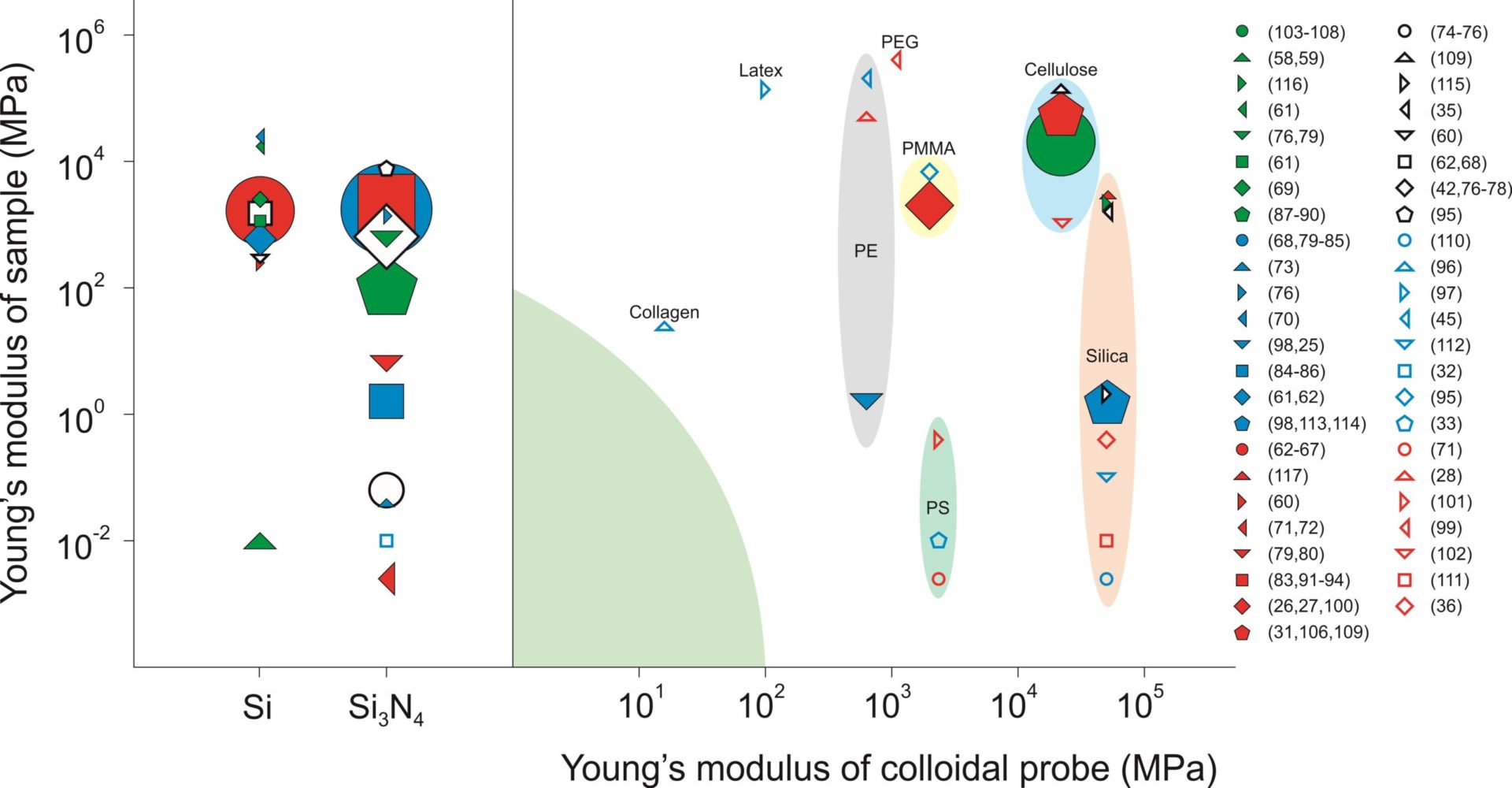
New results on 'Multi-scale salivary lubrication mechanism' published in Advanced Materials Interfaces
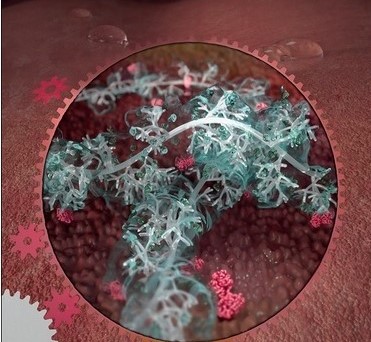
Salivary pellicle, the absorbed layer of saliva within the oral cavity, is an excellent aqueous lubricant that maintains low‐friction movement in the mouth that is of first‐order importance to human life for feeding and speech. Saliva is unique as compared to all other bodily lubricants, as it bathes the hardest (enamel) to one of the softest tissues in the mouth. Mucin, and more recently small molecular salivary proteins have been separately mooted as biological lubricants responsible for reducing friction in saliva. However, none of these by themselves have managed to replicate the remarkable aqueous lubrication in boundary and fluid film regimes as well as load‐bearing abilities of adsorbed real human saliva in direct in vitro experiments. This study titled "A self‐assembled binary protein model explains high‐performance salivary lubrication from macro to nanoscale"published in in Advanced Materials Interfaces sheds light on the molecular mechanism of salivary pellicle lubrication by involving multilayer fabrication using salivary proteins and multi-scale lubrication experiments. We have uncovered that an electrostatically driven multilayer architecture of binary salivary proteins, i.e., negatively charged salivary mucin (bovine submaxillary mucin, shown in branched bluish structure in the 1st Figure) and positively charged salivary protein (lactoferrin, shown in red globules in the 1st Figure) is key to facilitate the lubrication of soft sliding interfaces. Despite the simplicity of such a binary protein model compared to the complexity of multiple proteins in real saliva, the tribological properties at macro to nanoscale of this architecture closely resemble those of real human saliva. Experimental techniques (see 2nd Figure below) ranged from multi-scale tribological analysis covering 9 orders of magnitude of normal forces to dynamic film formation monitoring of the multilayered architecture using a quartz crystal microbalance with dissipation (QCM‐D) on substrates with varying surface chemistries, which were supported by self-consistent field theory calculations. With these experimental and theoretical approaches, we isolated the specific role of each protein component, and found that the positively-charged proteins (lactoferrin) in saliva acts as a “molecular glue” in the mucin network that synergistically promotes mucin–mucin assembly to trap water molecules. Such a network facilitates macromolecule‐mediated viscous lubrication, while the lactoferrin also glues salivary mucin strongly to the oral surfaces, thus enabling effective boundary lubrication as shown in the 1st Figure. Also, the multilayered (mucin-lactofferin-mucin)n architecture replicates the behavior of saliva at a certain ion concentration highlighting the importance of electrostatic interaction in the salivary lubrication phenomena. These unprecedented results present an optimal approach to study multi-scale aqueous lubrication, and will open the doors to fabrication of nature‐mimetic aqueous lubricants for a range of biological applications.
To read the full article, click here: https://doi.org/10.1002/admi.201901549
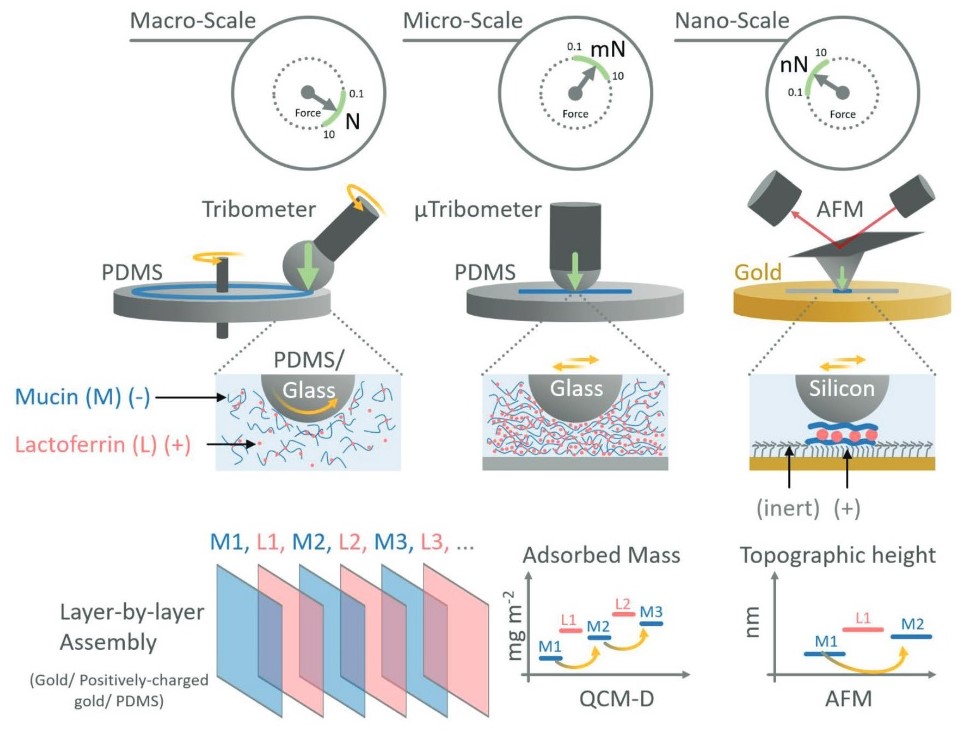
A Review on 'Ageing related changes in quantity and quality of saliva' published in Journal of Texture Studies
Saliva is crucial to oral processing of food and consequently is also related to the sensory and textural experience. It is often assumed that the secretion and properties of saliva change with age, which can result in dry mouth conditions, taste aberrations. Such changes may result in reduced nutrient intake and malnutrition besides adversely affecting the quality of life. Based on some recent research findings, this paper reviews our current understandings on age-dependent changes on quantity (bulk salivary flow rate) as well as quality of saliva (e.g. composition, viscosity, lubrication) in healthy elderly individuals published in Journal of Texture Studies (2020), Volume 50, 1, Pages 27-35 https://doi.org/10.1111/jtxs.12356. As shown in the summary figure below, it is clear that age-related changes in saliva are multifactorial. On one hand, a reduced salivary flow rate has an influence on increasing the ionic concentration of saliva, inadequate levels of fluid to coat the oral cavity and reduced ability to cope with the rate of pellicle replenishment. On the other hand, the decrease of salivary mucins and calcium might render loss of the lubricating properties of bio-lubricant saliva, which can result in reduced wettability of oral surfaces eventually leading to xerostomia, associated oral symptoms and potential aberrations in sensorial and/or textural perception. With carefully planned procedures, such as use of appropriate age groups, healthy versus older adults with health conditions and/or type of medication used, the knowledgebase on agre-dependent change in quantity and quality of saliva will be expanded offering potential applications to designing optimized food and oral therapies for maintaining oral health and nutritional status in elderly population.

New results on 'Microgels acting as viscosity modifiers and lubricants' published in Soft Matter
 Microgels are soft colloids made of cross-linked polymers that are capable of entrapping significant proportions of solvent or water. In this work published in Soft Matter, Volume 15, Pages 9599-9599, the mechanical performance of colloidal whey protein microgels (hydrodynamic diameter ∼100 nm measured using dynamic light scattering and atomic force microscopy (AFM) (see artwork (top) and experimental AFM image, (bottom)) of different rigidity (soft microgels (G′ ∼ 100.0 Pa) and hard microgels (G′ ∼ 10.0 kPa) ) dispersed in Newtonian or complex non-Newtonian fluids was investigated for the first time via rheology and soft tribology complemented with theoretical considerations. Dispersions of both soft microgels (G′ ∼ 100.0 Pa) and hard microgels (G′ ∼ 10.0 kPa) were observed to act as thickeners in low viscosity Newtonian fluids and correspondingly reduced the
Microgels are soft colloids made of cross-linked polymers that are capable of entrapping significant proportions of solvent or water. In this work published in Soft Matter, Volume 15, Pages 9599-9599, the mechanical performance of colloidal whey protein microgels (hydrodynamic diameter ∼100 nm measured using dynamic light scattering and atomic force microscopy (AFM) (see artwork (top) and experimental AFM image, (bottom)) of different rigidity (soft microgels (G′ ∼ 100.0 Pa) and hard microgels (G′ ∼ 10.0 kPa) ) dispersed in Newtonian or complex non-Newtonian fluids was investigated for the first time via rheology and soft tribology complemented with theoretical considerations. Dispersions of both soft microgels (G′ ∼ 100.0 Pa) and hard microgels (G′ ∼ 10.0 kPa) were observed to act as thickeners in low viscosity Newtonian fluids and correspondingly reduced the 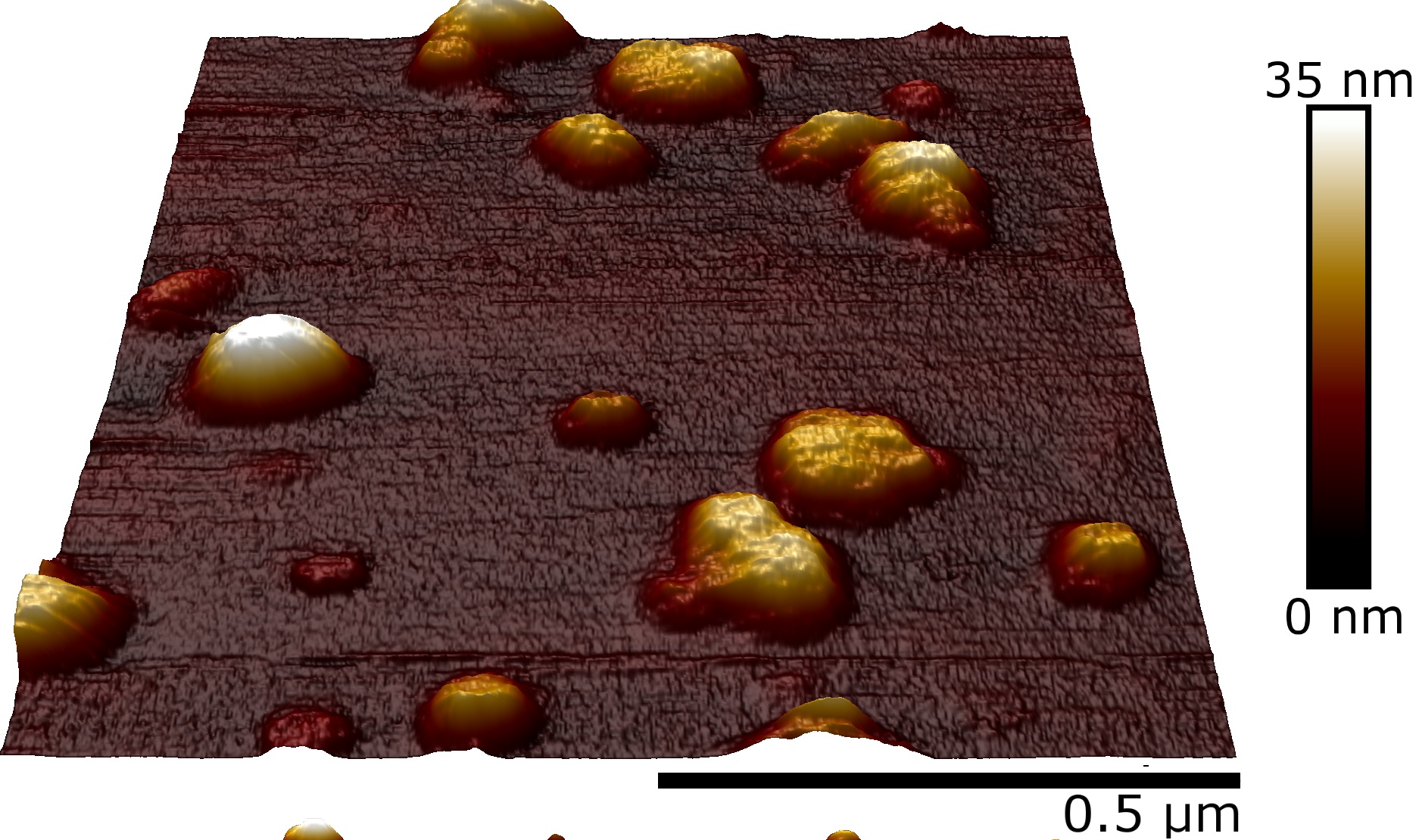 friction, latter decreased as a function of the increased rigidity of the microgels. Differently, in high viscosity continuum, the microgels acted as thinning agents and increased the friction. Variation of mechanical characteristics of microgels and continuum allowed establishing a relationship between the high shear rheology of the dispersions and their lubrication properties, which to the best of our knowledge has never been reported for this kind of complex continuum before. Thus, in order to obtain a benefit from microgels on the tribology performance of a dispersion, simplistically, it is necessary to have harder particles when the continuum viscosity is increased until the microgels become too hard that they can increase the abrasiveness in biological contacts. To read the full article, click here: https://doi.org/10.1039/C9SM01802F
friction, latter decreased as a function of the increased rigidity of the microgels. Differently, in high viscosity continuum, the microgels acted as thinning agents and increased the friction. Variation of mechanical characteristics of microgels and continuum allowed establishing a relationship between the high shear rheology of the dispersions and their lubrication properties, which to the best of our knowledge has never been reported for this kind of complex continuum before. Thus, in order to obtain a benefit from microgels on the tribology performance of a dispersion, simplistically, it is necessary to have harder particles when the continuum viscosity is increased until the microgels become too hard that they can increase the abrasiveness in biological contacts. To read the full article, click here: https://doi.org/10.1039/C9SM01802F
An Invited Review on 'Human and Model Saliva' published in Advances in Colloid and Interface Science
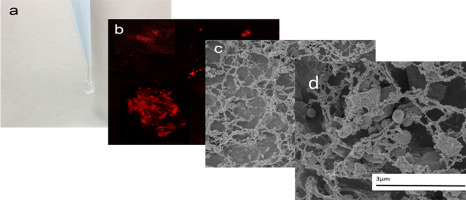 Human saliva, a seemingly simple aqueous fluid, is, in fact, an extraordinarily complex biocolloid that is not fully understood, despite many decades of study. In the last few decades, colloid scientists have attempted designing model (i.e. ‘saliva mimicking fluid’) salivary formulations to understand saliva-food colloid interactions in an in vitro set up and its contribution on microstructural aspects, lubrication properties and sensory perception. We present the first review published in Advances in Colloid and Interface Science 27 Article No. 102034 on the the current state of knowledge on bulk and interfacial properties of model saliva in comparison to real human saliva and highlight how far such model salivary formulations can match the properties of real human saliva. Real human saliva has an extremely complex architecture with multiple proteins and consequently specialized properties, understanding of which is far from complete. Hence, designing one standardized formulation of real human saliva is not straightforward. Indeed, model saliva and real human saliva show similarities in food colloid-saliva interaction outcomes when the model saliva emulates the biochemical composition (e.g. ions, negatively charged commercially available mucin) and the electrostatic charge, to a certain extent. Such understanding has helped to decipher the physico-chemical mechanisms behind sensory perceptions. However, considering the growing research interests on oral lubrication, model saliva studied mainly using less expensive and crude pig gastric mucin (PGM) is particularly problematic in replicating the lubrication and adsorption properties of saliva. Based on surface adsorption and lubrication studies from a wide pool of studies, we recommend that bovine submaxillary mucin (BSM) as the most optimal choice for the commercially available mucin source for model saliva preparation in terms of lubrication properties. Despite that mucin is recognized as the chief contributor to the lubricating properties of real saliva, it is evident that aqueous solution of mucin alone cannot fully represent various physicochemical and biophysical properties of saliva. Systematic studies on designing mucin-multilayers with targeted tribological properties have to be investigated in future, particularly with respect to examining its potential to replicate human salivary pellicle. Tribological measurements in the presence of mucins and mucin-polycationic additive systems (multilayers) in comparison to ex vivo human salivary conditioning films are needed in first place to warrant its use in food tribology experiments. To read this comprehensive review paper, please click in the open access link: https://doi.org/10.1016/j.cis.2019.102034
Human saliva, a seemingly simple aqueous fluid, is, in fact, an extraordinarily complex biocolloid that is not fully understood, despite many decades of study. In the last few decades, colloid scientists have attempted designing model (i.e. ‘saliva mimicking fluid’) salivary formulations to understand saliva-food colloid interactions in an in vitro set up and its contribution on microstructural aspects, lubrication properties and sensory perception. We present the first review published in Advances in Colloid and Interface Science 27 Article No. 102034 on the the current state of knowledge on bulk and interfacial properties of model saliva in comparison to real human saliva and highlight how far such model salivary formulations can match the properties of real human saliva. Real human saliva has an extremely complex architecture with multiple proteins and consequently specialized properties, understanding of which is far from complete. Hence, designing one standardized formulation of real human saliva is not straightforward. Indeed, model saliva and real human saliva show similarities in food colloid-saliva interaction outcomes when the model saliva emulates the biochemical composition (e.g. ions, negatively charged commercially available mucin) and the electrostatic charge, to a certain extent. Such understanding has helped to decipher the physico-chemical mechanisms behind sensory perceptions. However, considering the growing research interests on oral lubrication, model saliva studied mainly using less expensive and crude pig gastric mucin (PGM) is particularly problematic in replicating the lubrication and adsorption properties of saliva. Based on surface adsorption and lubrication studies from a wide pool of studies, we recommend that bovine submaxillary mucin (BSM) as the most optimal choice for the commercially available mucin source for model saliva preparation in terms of lubrication properties. Despite that mucin is recognized as the chief contributor to the lubricating properties of real saliva, it is evident that aqueous solution of mucin alone cannot fully represent various physicochemical and biophysical properties of saliva. Systematic studies on designing mucin-multilayers with targeted tribological properties have to be investigated in future, particularly with respect to examining its potential to replicate human salivary pellicle. Tribological measurements in the presence of mucins and mucin-polycationic additive systems (multilayers) in comparison to ex vivo human salivary conditioning films are needed in first place to warrant its use in food tribology experiments. To read this comprehensive review paper, please click in the open access link: https://doi.org/10.1016/j.cis.2019.102034
A Systematic Review on 'Oral Tribology-Sensory Relationship' published in Current Opinion in Food Science
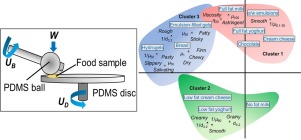
Oral tribology is rapidly entering into the food scientists’ toolbox because of its promises to predict surface-related mouthfeel perception. We present the first systematic review published in Current Opinion in Colloid Food Science 27 Pages 64-73 on the relationships between instrumental tribology measurements and sensory perception. In recent years, an impressive suite of commercially available and bespoke tribometers have surfaced to quantify the friction in presence of model and real food systems that allow the plotting of Stribeck curve. We discussed the advantages and disadvantages of these tribometers that are currently used across various food material science laboratories. It is exciting times that food scientists have already moved on from using steel-steel to steel-elastomers (such as polydemthylsiloxane (PDMS)) or PDMS–PDMS surfaces to mimic tongue-palate contacts, which have enabled developing empirical relationships with some sensory attributes that are either fat-related or non-fat related. We narrowed down the recent studies involving model and real food systems from 2016 onwards from 4857 to only 16 articles that found correlations between friction coefficients (μ) and specific sensory attributes, such as 'smoothness', 'slipperiness', 'pastiness'. However, considering lubrication is a system property and not an intrinsic material property of the lubricant, generalizability of such relationship can be questioned. It is highly likely that such existing relationship is only valid within the remits of those specific experimental conditions, and such tribology–sensory relationship might not hold well with other equipment or experimental conditions. Hence, it is crucial to build mechanistic hypotheses before trying to examine tribology–sensory relationships. Finally, to marry oral tribology to sensory, we have listed challenges and opportunities on the road to identify generalized relationships between instrument and sensory perception. To read the full paper, please click in the open access link: https://doi.org/10.1016/j.cofs.2019.05.007
New results on 'Rheology and Tribology of Polysaccharides' published in Biotribology
Combination of rheology and tribology can be a promising tool to characterize polysaccharides and understand their potential for acting as promising thickeners for dysphagia (swallowing disorder) patients. In this study, which has been recently published in Biotribology 33 Pages 14699-14708, gellan gum (GG) (0.075–0.3 wt%), a, bacterial exopolysaccharide from Sphingomonas elodea was  compared against commercial starch-based thickeners (modified starch with or without gums, 5 wt%) and xanthan gum (XG, 0.5–1.0 wt%) for rheological and oral tribological properties. Gellan gum is a linear tetrasaccharide, composed of 4)-L-rhamnopyranosyl-(α-1 to 3)-d-glucopyranosyl-(β-1 to 4)-D-glucuronopyranosyl-(β-1 to 4)-d-glucopyranosyl-(β-1 to 4) containing acetyl substituents on the 3-linked glucose. Gelation occurs upon cooling of a heat-treated gellan gum solutions under quiescent conditions through the aggregation of its double helices. We compared the polysaccharides using apparent viscosity, oral tribology using polydimethylsiloxane (PDMS) ball-on-disc set up and ζ-potential measurements. The measurements were conducted in presence of artificial saliva containing mucin with or without α-amylase at 37 °C to mimic oral conditions. Viscosity results suggested that the commercial starch-based thickeners behaved like water in orally relevant shear, largely associated with the hydrolysis of modified starch by α-amylase, whereas, XG and GG showed no responsiveness to α-amylase. In the case of oral tribology, artificial saliva containing mucin adsorbed to the PDMS surfaces reducing friction as compared to water. From a tribological perspective, the lubrication profile of all thickeners was found to be controlled mainly by their viscous component. Hence, samples with higher viscosities at orally relevant shear rates (>0.1 Pa s at 100 s−1 shear rates i.e. two orders of magnitude higher viscosity than water) showed promising lubrication performances (i.e. μ ≤ 0.07 in the mixed regimes) as compared to that of water (μ ~ 1.0 in the mixed regimes) due to their larger drag force to allow entrainment as compared to water. The increase in boundary friction coefficients in commercial starch-based thickeners was likely associated with α-amylase-induced hydrolysis, increasing the PDMS-PDMS asperity contacts. In simulated oral conditions, the increase in friction coefficients in presence of XG and GG was influenced by the exclusion of mucin-rich artificial saliva from the PDMS surfaces due to electrostatic interaction between the gums and mucin. A combination of rheological and tribological techniques in orally relevant conditions appears as a reliable approach to understand the potential of GG (0.3 wt%) to act as a dysphagia thickener that offers similar mechanical properties as XG (1.0 wt%) at a lower concentration. Further studies on extensional viscosity measurement of gellan gum in simulated oral processing conditions and relationship of instrumental data with sensory measurements (e.g. thickness, cohesiveness, stickiness) are needed to warrant its applications in dysphagia management. You can read the paper at https://doi.org/10.1016/j.biotri.2019.02.002
compared against commercial starch-based thickeners (modified starch with or without gums, 5 wt%) and xanthan gum (XG, 0.5–1.0 wt%) for rheological and oral tribological properties. Gellan gum is a linear tetrasaccharide, composed of 4)-L-rhamnopyranosyl-(α-1 to 3)-d-glucopyranosyl-(β-1 to 4)-D-glucuronopyranosyl-(β-1 to 4)-d-glucopyranosyl-(β-1 to 4) containing acetyl substituents on the 3-linked glucose. Gelation occurs upon cooling of a heat-treated gellan gum solutions under quiescent conditions through the aggregation of its double helices. We compared the polysaccharides using apparent viscosity, oral tribology using polydimethylsiloxane (PDMS) ball-on-disc set up and ζ-potential measurements. The measurements were conducted in presence of artificial saliva containing mucin with or without α-amylase at 37 °C to mimic oral conditions. Viscosity results suggested that the commercial starch-based thickeners behaved like water in orally relevant shear, largely associated with the hydrolysis of modified starch by α-amylase, whereas, XG and GG showed no responsiveness to α-amylase. In the case of oral tribology, artificial saliva containing mucin adsorbed to the PDMS surfaces reducing friction as compared to water. From a tribological perspective, the lubrication profile of all thickeners was found to be controlled mainly by their viscous component. Hence, samples with higher viscosities at orally relevant shear rates (>0.1 Pa s at 100 s−1 shear rates i.e. two orders of magnitude higher viscosity than water) showed promising lubrication performances (i.e. μ ≤ 0.07 in the mixed regimes) as compared to that of water (μ ~ 1.0 in the mixed regimes) due to their larger drag force to allow entrainment as compared to water. The increase in boundary friction coefficients in commercial starch-based thickeners was likely associated with α-amylase-induced hydrolysis, increasing the PDMS-PDMS asperity contacts. In simulated oral conditions, the increase in friction coefficients in presence of XG and GG was influenced by the exclusion of mucin-rich artificial saliva from the PDMS surfaces due to electrostatic interaction between the gums and mucin. A combination of rheological and tribological techniques in orally relevant conditions appears as a reliable approach to understand the potential of GG (0.3 wt%) to act as a dysphagia thickener that offers similar mechanical properties as XG (1.0 wt%) at a lower concentration. Further studies on extensional viscosity measurement of gellan gum in simulated oral processing conditions and relationship of instrumental data with sensory measurements (e.g. thickness, cohesiveness, stickiness) are needed to warrant its applications in dysphagia management. You can read the paper at https://doi.org/10.1016/j.biotri.2019.02.002
An Invited Review on 'Oral Lubrication' published in Current Opinion in Colloid & Interface Science
Oral lubrication deals with one of the most intricate examples of bio-lubrication, where surfaces under sliding conditions span from the hardest enamel to soft oral tissues in human physiology. The situation is more complex as these surfaces are covered by an endogenous biolubricant 'saliva' before the exogenous food particles can wet, stick, or slip at the surfaces. In this Invited Review published in the Special Issue of “Outstanding Young Researchers in Colloid and Interface Science” in Current Opinion in Colloid and Interface Science 39 Pages 61-75, we covered the latest advances in tribology research in soft oral contacts and theoretical developments relevant for this field. We have briefly covered the material physics and chemistry (roughness, wettability and modulus) of human soft oral architectures under shear fields, which influence oral lubrication and highlight the transition from rheological to tribological limits. Talking about surface roughness of human tongue, the human filiform papillae can contain 6–12 protruding hairs, each of which are 34–50 μm wide contributing to overall 420–500 μm diameter in the root and height of 250 μm, whereas fungiform papillae almost doubling the diameter of the filiform ones. Overall, all these surface topographic analyses of tongue point out that engineering of these filiform papillae on tongue surface by nature provides it a more coarse texture than even a 100-grit sandpaper. However, the tongue does not feel as coarse as represented by its roughness largely due its reduced “stiffness” (Young's modulus).
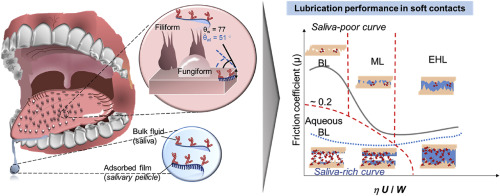 In terms of lubricants, we discussed one endogenous lubricant (saliva) and one exogenous lubricant (food-based microgels/hydrogel particles) to capture the recent knowledge gathered in how they reduce friction in sliding soft contacts in an in vitro set up. We discussed the legacy of materials used for oral lubrication studies in the last decade covering latest experiments conducted mainly using polydimethylsiloxane (PDMS) tribopairs in in vitro and pig tongue surfaces in ex vivo experiments. For example, according to classical Hertz contact theory, in the case of the popular PDMS ball on disc tribological set-up (E* ∼ 2 MPa, R ∼ 0.01 m) with a typical load of 2 N, the maximum contact pressure is ∼200 kPa. This pressure is about one order of magnitude higher than that measured in oral-palate contact of healthy adults (30–50 kPa). For future, we highlight the window of opportunity offered by a range of polymeric surfaces together with the advent of 3D Printing technology that can be used to emulate oral surfaces with accurate roughness and modulus to enable colloid scientists to underpin principles that govern oral lubrication at colloidal scale. To read the full paper, please click in the link: https://doi.org/10.1016/j.cocis.2019.01.008
In terms of lubricants, we discussed one endogenous lubricant (saliva) and one exogenous lubricant (food-based microgels/hydrogel particles) to capture the recent knowledge gathered in how they reduce friction in sliding soft contacts in an in vitro set up. We discussed the legacy of materials used for oral lubrication studies in the last decade covering latest experiments conducted mainly using polydimethylsiloxane (PDMS) tribopairs in in vitro and pig tongue surfaces in ex vivo experiments. For example, according to classical Hertz contact theory, in the case of the popular PDMS ball on disc tribological set-up (E* ∼ 2 MPa, R ∼ 0.01 m) with a typical load of 2 N, the maximum contact pressure is ∼200 kPa. This pressure is about one order of magnitude higher than that measured in oral-palate contact of healthy adults (30–50 kPa). For future, we highlight the window of opportunity offered by a range of polymeric surfaces together with the advent of 3D Printing technology that can be used to emulate oral surfaces with accurate roughness and modulus to enable colloid scientists to underpin principles that govern oral lubrication at colloidal scale. To read the full paper, please click in the link: https://doi.org/10.1016/j.cocis.2019.01.008
New results (with Slide Presentation) on 'Lubrication of Emulsion Microgel Particles' published in ACS Applied Materials & Interfaces 
Biolubricants reduce friction between soft biological contacting surfaces, such as the tear in eyes, saliva in the oral cavity, synovial fluid in the articular joints, to prevent discomfort and wear of epithelial tissues and cartilage. The use of submicron to micron sized particles (e.g., microgels) as biolubricant additives has attracted recent attention in biomaterial science research due to their ability to reduce friction and wear in the boundary regime of sliding contact in biological areas, such as tongue-oral palate contacts, cartilage, or eye blinking. In this paper published in ACS Applied Materials & Interfaces 10 (32), Pages 26893–26905, starch-based emulsion microgel particles with different starch (15 and 20 wt %) and oil contents (0–15 wt %) were synthesized, and their lubrication performance under physiologically relevant conditions was investigated. Emulsion microgels were subjected to skin mimicking or oral cavity mimicking conditions, i.e., smooth hydrophobic polydimethylsiloxane ball-on-disc tribological tests, in the absence or presence of salivary enzyme (α-amylase). In the absence of enzyme, emulsion microgel particles (30–60 vol % particle content) conserved the lubricating properties of emulsion droplets, providing considerably lower friction coefficients (μ ≤ 0.1) in the mixed lubrication regime compared to plain microgel particles (0 wt % oil). Upon addition of enzyme, the lubrication performance of emulsion microgel particles became strongly dependent on the particles’ oil content. Microgel particles encapsulating 5–10 wt % oil showed a double plateau mixed lubrication regime having a lowest friction coefficient μ ∼ 0.03 and highest μ ∼ 0.1, the latter higher than with plain microgel particles. An oil content of 15 wt % was necessary for the microgel particles to lubricate similarly to the emulsion droplets, where both systems showed a normal mixed lubrication regime with μ ≤ 0.03. The observed trends in tribology, theoretical considerations, and the combined results of rheology, light scattering, and confocal fluorescence microscopy suggested that the mechanism behind the low friction coefficients was a synergistic enzyme- and shear-triggered release of the emulsion droplets, improving lubrication. The present work thus demonstrates experimentally and theoretically emulsion microgel particle as a novel biolubricant additive with stimuli-responsive properties capable of providing efficient boundary lubrication between soft polymeric surfaces. At the same time, the additive should provide an effective delivery vehicle for oil soluble ingredients in aqueous media. These findings demonstrate that emulsion microgel particles can be developed into multifunctional biolubricant additives for future use in numerous soft matter applications where both lubrication and controlled release of bioactives are essential.. To read the full paper, please click in the link https://pubs.acs.org/doi/10.1021/acsami.8b07883. To hear an audio presentation on this paper by Ophelie Torres, please click below:
New results on Aqueous Lubrication using Microgel Particles published in Langmuir
Aqueous lubrication has emerged as an active research area in recent years due to its prevalence in nature in biotribological contacts and its enormous technological soft-matter applications. In this study, which has been recently published in Langmuir 33 Pages 14699-14708, we designed aqueous dispersions of biocompatible whey-protein microgel particles (WPM) (10–80 vol %) cross-linked via disulfide bonding and focused on understanding their rheological, structural and biotribological properties (smooth polydimethylsiloxane (PDMS) contacts, Ra < 50 nm, ball-on-disk set up). The WPM particles (Dh = 380 nm) displayed shear-thinning behavior and  facilitated lubrication between bare hydrophobic PDMS surfaces (HB) (static water contact angle 108°), leading to a 10-fold reduction in boundary friction force at increased volume fraction (ϕ ≥ 65%), largely attributed to the close packing-mediated layer of particles between the asperity contacts acting as “true surface-separators”. In addition, WPM particles employed a rolling mechanism analogous to “ball bearings”, the latter supported by negligible change in size and microstructure of the WPM particles after tribology. An ultralow boundary friction coefficient, μ ≤ 0.03 was achieved using WPM between O2 plasma-treated hydrophilic PDMS contacts coated with bovine submaxillary mucin (HL+BSM) (static water contact angle 47°), and electron micrographs revealed that the WPM particles spread effectively as a layer of particles even at low ϕ∼ 10%, forming a lubricating load-bearing film that prevented the two surfaces from true adhesive contact. However, above an optimum volume fraction, μ increased in HL+BSM surfaces due to the packing and interpenetration of particles that possibly impeded effective rolling, explaining the increase in friction. The present work demonstrates a novel approach for providing ultralow friction in soft polymeric surfaces using proteinaceous microgel particles that satisfy both load bearing and kinematic requirements. To read the full paper, please click in the link https://doi.org/10.1021/acs.langmuir.7b03627
facilitated lubrication between bare hydrophobic PDMS surfaces (HB) (static water contact angle 108°), leading to a 10-fold reduction in boundary friction force at increased volume fraction (ϕ ≥ 65%), largely attributed to the close packing-mediated layer of particles between the asperity contacts acting as “true surface-separators”. In addition, WPM particles employed a rolling mechanism analogous to “ball bearings”, the latter supported by negligible change in size and microstructure of the WPM particles after tribology. An ultralow boundary friction coefficient, μ ≤ 0.03 was achieved using WPM between O2 plasma-treated hydrophilic PDMS contacts coated with bovine submaxillary mucin (HL+BSM) (static water contact angle 47°), and electron micrographs revealed that the WPM particles spread effectively as a layer of particles even at low ϕ∼ 10%, forming a lubricating load-bearing film that prevented the two surfaces from true adhesive contact. However, above an optimum volume fraction, μ increased in HL+BSM surfaces due to the packing and interpenetration of particles that possibly impeded effective rolling, explaining the increase in friction. The present work demonstrates a novel approach for providing ultralow friction in soft polymeric surfaces using proteinaceous microgel particles that satisfy both load bearing and kinematic requirements. To read the full paper, please click in the link https://doi.org/10.1021/acs.langmuir.7b03627
